Grace Elliot's Blog: 'Familiar Felines.' , page 11
May 21, 2014
The Georgians: And So to Bed
On a recent tour of the Queen's State Apartments at Hampton Court Palace, my attention was taken by a chest / truckle bed in Queen's Guard Chamber.
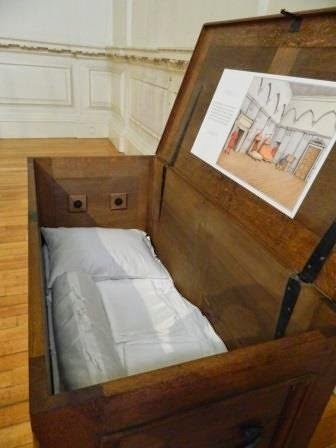 The cot / chest in which a yeoman guard
The cot / chest in which a yeoman guard
might snatch a quick nap.Apparently, this was where a weary yeoman guard could nap during the long watches of the night. This set me thinking and hence this post about the three beds on view in the state apartments.
The yeoman guard's bed was basically a trunk in disguise. With the lid down, you'd barely notice it as anything other than an underwhelming piece of furniture in the guard room.
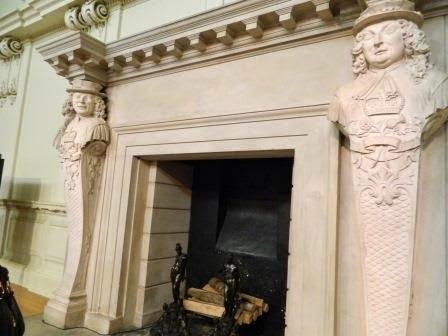 The fireplace in the Guard Room -
The fireplace in the Guard Room -
Two yeoman guards are featured in the caryatids. However, just a few rooms deeper into the royal apartments in the State Bedchamber the contrast with couldn't be greater as the Royal Bed of State is revealed in all its crimson brocade splendour.
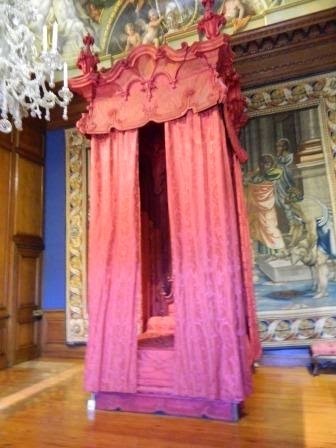 The Royal Bed of State.In a room dripping with opulence and decorated with fabulous paintings portraying the power of the royal family, we find a bed fit for a king...and queen. But just because this is a bed, doesn't imply any degree of privacy. Quite the opposite in fact. A courtier, or petitioner of influence, might be shown into this inner sanctum in order to present his business to the king.
The Royal Bed of State.In a room dripping with opulence and decorated with fabulous paintings portraying the power of the royal family, we find a bed fit for a king...and queen. But just because this is a bed, doesn't imply any degree of privacy. Quite the opposite in fact. A courtier, or petitioner of influence, might be shown into this inner sanctum in order to present his business to the king.
 The awe-inspiring ceiling in the State Bedchamber.
The awe-inspiring ceiling in the State Bedchamber.
Designed to impress!Fair enough the courtier wouldn't just wander in, he'd need to be sanctioned by the Yeoman Guard and then be escorted through the Queen's Presence Chamber, the Dining Room, the Privy Chambers and Drawing Room in order to reach the State Bedroom - but the principle remains that a person might do business with the king as he dressed.
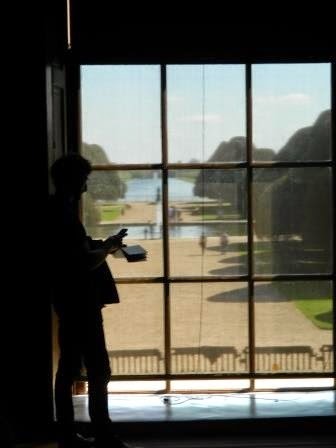 The view from the State Bedchamber.The idea is actually quite a practical one. In the 18th century it took an hour or more for the monarch to rise, dress, be coiffured and kitted out in all his royal finery. Neither did the king dress himself, but was attended by trusted servants who attended to his bodily needs as if he were a mannequin.
The view from the State Bedchamber.The idea is actually quite a practical one. In the 18th century it took an hour or more for the monarch to rise, dress, be coiffured and kitted out in all his royal finery. Neither did the king dress himself, but was attended by trusted servants who attended to his bodily needs as if he were a mannequin.
Deeper within the State Apartments we find the private rooms. It is here, in the Queen's Bedchamber. Heaven's above - this room had a lock on it and was a rare place where the royal couple might seek some privacy.
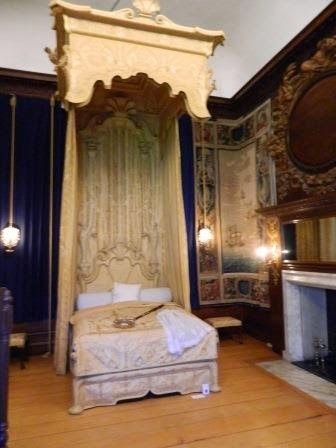 The Queen's bed within her private roomsQueen Caroline would have slept here in the company of her husband, George II. Adjacent is a private dining room, a private bathroom and an oratory (prayer room), so whilst their idea of a family life wasn't exactly normal, with a small army of servants coming and going, one can at least hope the courtiers and petitioners didn't intrude this far.
The Queen's bed within her private roomsQueen Caroline would have slept here in the company of her husband, George II. Adjacent is a private dining room, a private bathroom and an oratory (prayer room), so whilst their idea of a family life wasn't exactly normal, with a small army of servants coming and going, one can at least hope the courtiers and petitioners didn't intrude this far.
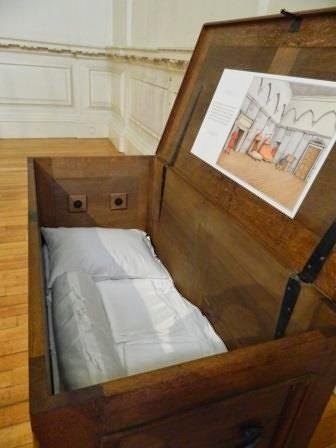 Contrasting places to rest a weary head:
Contrasting places to rest a weary head:
A trunk or state bed.
Which would you prefer? And finally...

 The cot / chest in which a yeoman guard
The cot / chest in which a yeoman guardmight snatch a quick nap.Apparently, this was where a weary yeoman guard could nap during the long watches of the night. This set me thinking and hence this post about the three beds on view in the state apartments.
The yeoman guard's bed was basically a trunk in disguise. With the lid down, you'd barely notice it as anything other than an underwhelming piece of furniture in the guard room.
 The fireplace in the Guard Room -
The fireplace in the Guard Room -Two yeoman guards are featured in the caryatids. However, just a few rooms deeper into the royal apartments in the State Bedchamber the contrast with couldn't be greater as the Royal Bed of State is revealed in all its crimson brocade splendour.
 The Royal Bed of State.In a room dripping with opulence and decorated with fabulous paintings portraying the power of the royal family, we find a bed fit for a king...and queen. But just because this is a bed, doesn't imply any degree of privacy. Quite the opposite in fact. A courtier, or petitioner of influence, might be shown into this inner sanctum in order to present his business to the king.
The Royal Bed of State.In a room dripping with opulence and decorated with fabulous paintings portraying the power of the royal family, we find a bed fit for a king...and queen. But just because this is a bed, doesn't imply any degree of privacy. Quite the opposite in fact. A courtier, or petitioner of influence, might be shown into this inner sanctum in order to present his business to the king. The awe-inspiring ceiling in the State Bedchamber.
The awe-inspiring ceiling in the State Bedchamber.Designed to impress!Fair enough the courtier wouldn't just wander in, he'd need to be sanctioned by the Yeoman Guard and then be escorted through the Queen's Presence Chamber, the Dining Room, the Privy Chambers and Drawing Room in order to reach the State Bedroom - but the principle remains that a person might do business with the king as he dressed.
 The view from the State Bedchamber.The idea is actually quite a practical one. In the 18th century it took an hour or more for the monarch to rise, dress, be coiffured and kitted out in all his royal finery. Neither did the king dress himself, but was attended by trusted servants who attended to his bodily needs as if he were a mannequin.
The view from the State Bedchamber.The idea is actually quite a practical one. In the 18th century it took an hour or more for the monarch to rise, dress, be coiffured and kitted out in all his royal finery. Neither did the king dress himself, but was attended by trusted servants who attended to his bodily needs as if he were a mannequin. Deeper within the State Apartments we find the private rooms. It is here, in the Queen's Bedchamber. Heaven's above - this room had a lock on it and was a rare place where the royal couple might seek some privacy.
 The Queen's bed within her private roomsQueen Caroline would have slept here in the company of her husband, George II. Adjacent is a private dining room, a private bathroom and an oratory (prayer room), so whilst their idea of a family life wasn't exactly normal, with a small army of servants coming and going, one can at least hope the courtiers and petitioners didn't intrude this far.
The Queen's bed within her private roomsQueen Caroline would have slept here in the company of her husband, George II. Adjacent is a private dining room, a private bathroom and an oratory (prayer room), so whilst their idea of a family life wasn't exactly normal, with a small army of servants coming and going, one can at least hope the courtiers and petitioners didn't intrude this far. Contrasting places to rest a weary head:
Contrasting places to rest a weary head:A trunk or state bed.
Which would you prefer? And finally...

Published on May 21, 2014 01:30
May 14, 2014
18th Century Pastimes: Animal Baiting
Just because a sport is popular, is no guarantee of good taste and when it comes to entertainment what appeals to one person can be repulsive to another. This is certainly true of the 18th century craze for animal baiting, which from the distance of the modern day most right-minded people find disgusting.
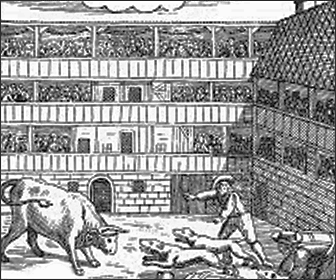 The 'sport' of animal-baiting was extremely popular in the past
The 'sport' of animal-baiting was extremely popular in the past
Baiting involved forcing animals or birds, to fight one another, often to the death. The most ancient form was cock-fighting which has also been suggested as one of the world’s oldest spectator sports, going back over 6,000 years to ancient Persia. Roman mosaics exist that show two cocks squaring up for a winner’s purse. In 17thcentury Britain the ‘sport’ was so popular and widespread that the term ‘cockpit’ (the pit in which cocks fought) was in common parlance to mean a place of entertainment or frenzied activity and in Tudor times, Whitehall had its own permanent fighting arena – the Cockpit-in-Court.Cocks were pitched against each other because of their natural aggression to other males and James Boswell noted in 1762 after attending a fight how the birds fought with ‘amazing bitterness and resolution’ to the end. It took until 1835 for cock-fighting to be banned but the legislation did not have sufficient ‘teeth’ and amazingly the activity continued in a widespread manner until the 1911 Protection of Animals Act made it illegal to prepare a place for cock-fighting.
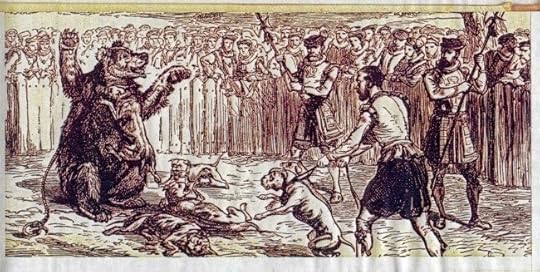 The distressing 'sport' of bear-baitingThe bear was another animal used for baiting and the ‘sport’s’ fans included King Henry VIII, who had a special bear pit constructed at Whitehall, as well as Queen Elizabeth I. Tudor attitudes were very different to the modern day when such cruelty is to be abhorred, indeed Elizabeth over-ruled Parliament when they tried to stop bear-baiting on Sundays. Elizabeth’s court favourite, Robert Dudley, Earl of Leceister, regularly hosted bear baitings, one of which is described below by Robert Laneham (1575).“Thursday, the fourteenth of July, and the sixth day of her Majesty’s coming, a great sort of bandogs [mastiff] were then tied in the outer court and thirteen bears in the inner . . . It was a sport very pleasant, of these beasts, to see the bear with his pink eyes leering after his enemies approach, the nimbleness and wayt [wait] of the dog to take his advantage, and the force and experience of the bear again to avoid the assaults. If he were bitten in one place, how he would pinch in another to get free, that if he were taken once, then what shift, with biting, with clawing, with roaring, tossing and tumbling, he would work to wind himself free from them. And when he was loose, to shake his ears twice or thrice with the blood and the slather about his physiognomy, was a matter of goodly relief.”
The distressing 'sport' of bear-baitingThe bear was another animal used for baiting and the ‘sport’s’ fans included King Henry VIII, who had a special bear pit constructed at Whitehall, as well as Queen Elizabeth I. Tudor attitudes were very different to the modern day when such cruelty is to be abhorred, indeed Elizabeth over-ruled Parliament when they tried to stop bear-baiting on Sundays. Elizabeth’s court favourite, Robert Dudley, Earl of Leceister, regularly hosted bear baitings, one of which is described below by Robert Laneham (1575).“Thursday, the fourteenth of July, and the sixth day of her Majesty’s coming, a great sort of bandogs [mastiff] were then tied in the outer court and thirteen bears in the inner . . . It was a sport very pleasant, of these beasts, to see the bear with his pink eyes leering after his enemies approach, the nimbleness and wayt [wait] of the dog to take his advantage, and the force and experience of the bear again to avoid the assaults. If he were bitten in one place, how he would pinch in another to get free, that if he were taken once, then what shift, with biting, with clawing, with roaring, tossing and tumbling, he would work to wind himself free from them. And when he was loose, to shake his ears twice or thrice with the blood and the slather about his physiognomy, was a matter of goodly relief.”
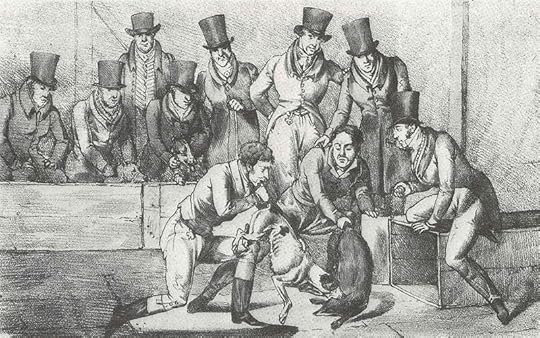 These 'gentlemen' are watching badger-baitingIncredibly, this cruel activity only died out, in the 18th century, because bears which were extinct in Britain, also became rare in Europe and therefore too costly to import. Another example is bull-baiting. The bull was tied to a stake on a tether with a 30 foot radius. The idea of the ‘sport’ was for dogs to immobilize the bull. This was part justified on the rather thin belief that baiting improved bull meat. Indeed, some towns had bye-laws stating meat from a bull could not be sold unless the animal first been baited.
These 'gentlemen' are watching badger-baitingIncredibly, this cruel activity only died out, in the 18th century, because bears which were extinct in Britain, also became rare in Europe and therefore too costly to import. Another example is bull-baiting. The bull was tied to a stake on a tether with a 30 foot radius. The idea of the ‘sport’ was for dogs to immobilize the bull. This was part justified on the rather thin belief that baiting improved bull meat. Indeed, some towns had bye-laws stating meat from a bull could not be sold unless the animal first been baited.
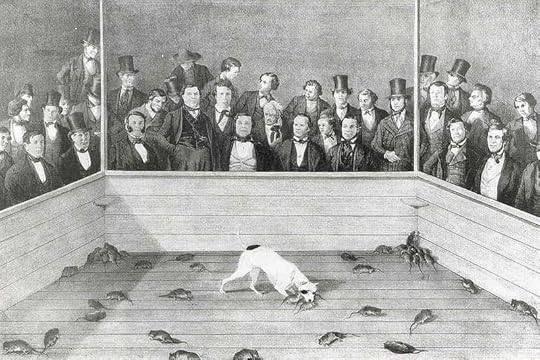 Rat-baiting
Rat-baiting
In the early 19th century social attitudes began to change, but when the topic of banning bull-baiting was debated in parliament, the future prime minister Sir William Pulteney argued that: ‘The amusement inspired courage and produced a nobleness of sentiment and elevation of mind.’An example of the wide spread nature of bull-baiting is found in the name of the main commercial area of the city of Birmingham, UK – which is called the Bull Ring (or Bullring in the modern day). The ‘ring’ refers to the hoop of iron to which the bull was tethered for baiting prior to slaughter. [It is perhaps testament to the British love of tradition that the 21st century contraction of Bull Ring to Bullring caused anger amongst the locals who looked on the former as the true, historic spelling.]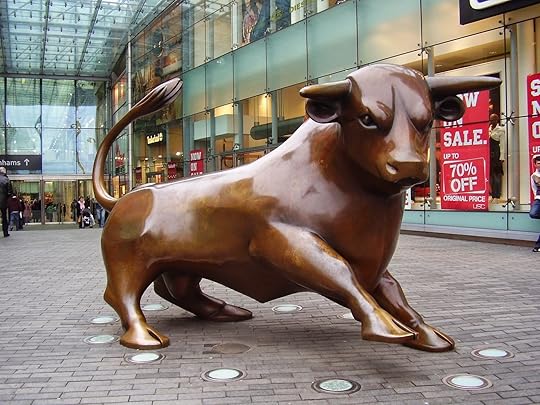 A modern nod to the origins of Birmingham BullringAnd finally…the dogs used in the vile activity of bull baiting were bred for purpose and when bull-baiting was banned, the numbers of these dogs fell dramatically. Around 1865 dog fanciers worried about the breed going into decline set about breeding the remaining animals together so as to preserve the breed. It is from these dogs that the British bulldog was derived – that national symbol of determination and fighting spirit!
A modern nod to the origins of Birmingham BullringAnd finally…the dogs used in the vile activity of bull baiting were bred for purpose and when bull-baiting was banned, the numbers of these dogs fell dramatically. Around 1865 dog fanciers worried about the breed going into decline set about breeding the remaining animals together so as to preserve the breed. It is from these dogs that the British bulldog was derived – that national symbol of determination and fighting spirit!

 The 'sport' of animal-baiting was extremely popular in the past
The 'sport' of animal-baiting was extremely popular in the pastBaiting involved forcing animals or birds, to fight one another, often to the death. The most ancient form was cock-fighting which has also been suggested as one of the world’s oldest spectator sports, going back over 6,000 years to ancient Persia. Roman mosaics exist that show two cocks squaring up for a winner’s purse. In 17thcentury Britain the ‘sport’ was so popular and widespread that the term ‘cockpit’ (the pit in which cocks fought) was in common parlance to mean a place of entertainment or frenzied activity and in Tudor times, Whitehall had its own permanent fighting arena – the Cockpit-in-Court.Cocks were pitched against each other because of their natural aggression to other males and James Boswell noted in 1762 after attending a fight how the birds fought with ‘amazing bitterness and resolution’ to the end. It took until 1835 for cock-fighting to be banned but the legislation did not have sufficient ‘teeth’ and amazingly the activity continued in a widespread manner until the 1911 Protection of Animals Act made it illegal to prepare a place for cock-fighting.
 The distressing 'sport' of bear-baitingThe bear was another animal used for baiting and the ‘sport’s’ fans included King Henry VIII, who had a special bear pit constructed at Whitehall, as well as Queen Elizabeth I. Tudor attitudes were very different to the modern day when such cruelty is to be abhorred, indeed Elizabeth over-ruled Parliament when they tried to stop bear-baiting on Sundays. Elizabeth’s court favourite, Robert Dudley, Earl of Leceister, regularly hosted bear baitings, one of which is described below by Robert Laneham (1575).“Thursday, the fourteenth of July, and the sixth day of her Majesty’s coming, a great sort of bandogs [mastiff] were then tied in the outer court and thirteen bears in the inner . . . It was a sport very pleasant, of these beasts, to see the bear with his pink eyes leering after his enemies approach, the nimbleness and wayt [wait] of the dog to take his advantage, and the force and experience of the bear again to avoid the assaults. If he were bitten in one place, how he would pinch in another to get free, that if he were taken once, then what shift, with biting, with clawing, with roaring, tossing and tumbling, he would work to wind himself free from them. And when he was loose, to shake his ears twice or thrice with the blood and the slather about his physiognomy, was a matter of goodly relief.”
The distressing 'sport' of bear-baitingThe bear was another animal used for baiting and the ‘sport’s’ fans included King Henry VIII, who had a special bear pit constructed at Whitehall, as well as Queen Elizabeth I. Tudor attitudes were very different to the modern day when such cruelty is to be abhorred, indeed Elizabeth over-ruled Parliament when they tried to stop bear-baiting on Sundays. Elizabeth’s court favourite, Robert Dudley, Earl of Leceister, regularly hosted bear baitings, one of which is described below by Robert Laneham (1575).“Thursday, the fourteenth of July, and the sixth day of her Majesty’s coming, a great sort of bandogs [mastiff] were then tied in the outer court and thirteen bears in the inner . . . It was a sport very pleasant, of these beasts, to see the bear with his pink eyes leering after his enemies approach, the nimbleness and wayt [wait] of the dog to take his advantage, and the force and experience of the bear again to avoid the assaults. If he were bitten in one place, how he would pinch in another to get free, that if he were taken once, then what shift, with biting, with clawing, with roaring, tossing and tumbling, he would work to wind himself free from them. And when he was loose, to shake his ears twice or thrice with the blood and the slather about his physiognomy, was a matter of goodly relief.” These 'gentlemen' are watching badger-baitingIncredibly, this cruel activity only died out, in the 18th century, because bears which were extinct in Britain, also became rare in Europe and therefore too costly to import. Another example is bull-baiting. The bull was tied to a stake on a tether with a 30 foot radius. The idea of the ‘sport’ was for dogs to immobilize the bull. This was part justified on the rather thin belief that baiting improved bull meat. Indeed, some towns had bye-laws stating meat from a bull could not be sold unless the animal first been baited.
These 'gentlemen' are watching badger-baitingIncredibly, this cruel activity only died out, in the 18th century, because bears which were extinct in Britain, also became rare in Europe and therefore too costly to import. Another example is bull-baiting. The bull was tied to a stake on a tether with a 30 foot radius. The idea of the ‘sport’ was for dogs to immobilize the bull. This was part justified on the rather thin belief that baiting improved bull meat. Indeed, some towns had bye-laws stating meat from a bull could not be sold unless the animal first been baited.  Rat-baiting
Rat-baitingIn the early 19th century social attitudes began to change, but when the topic of banning bull-baiting was debated in parliament, the future prime minister Sir William Pulteney argued that: ‘The amusement inspired courage and produced a nobleness of sentiment and elevation of mind.’An example of the wide spread nature of bull-baiting is found in the name of the main commercial area of the city of Birmingham, UK – which is called the Bull Ring (or Bullring in the modern day). The ‘ring’ refers to the hoop of iron to which the bull was tethered for baiting prior to slaughter. [It is perhaps testament to the British love of tradition that the 21st century contraction of Bull Ring to Bullring caused anger amongst the locals who looked on the former as the true, historic spelling.]
 A modern nod to the origins of Birmingham BullringAnd finally…the dogs used in the vile activity of bull baiting were bred for purpose and when bull-baiting was banned, the numbers of these dogs fell dramatically. Around 1865 dog fanciers worried about the breed going into decline set about breeding the remaining animals together so as to preserve the breed. It is from these dogs that the British bulldog was derived – that national symbol of determination and fighting spirit!
A modern nod to the origins of Birmingham BullringAnd finally…the dogs used in the vile activity of bull baiting were bred for purpose and when bull-baiting was banned, the numbers of these dogs fell dramatically. Around 1865 dog fanciers worried about the breed going into decline set about breeding the remaining animals together so as to preserve the breed. It is from these dogs that the British bulldog was derived – that national symbol of determination and fighting spirit! 
Published on May 14, 2014 06:52
May 7, 2014
"Paradise for Women and Hell for Horses": Sexism in the 17th and 18th Centuries
“[England is] a paradise for women and hell for horses.” Robert Burton 1651
 A woman's role was to marry and have children.
A woman's role was to marry and have children.
The above quote is from the 17thcentury, but the underlying sentiment remains true a century later in Georgian times. Just in case the word ‘paradise’ confuses you – consider that women are being put in the same category as horses, that is, both subject to men, their lord and master. In effect Burton is saying that women should consider themselves jolly lucky to be coddled and generously looked after by their menfolk. Puts a different complexion on the term ‘paradise’ doesn’t it? If you aren’t convinced, then consider this quote by Judge Buller, in 1782, who ruled on a point of English law concerning women and concluded: “[It is] perfectly legal for a man to beat his wife, as long as he used a stick no thicker than his thumb.”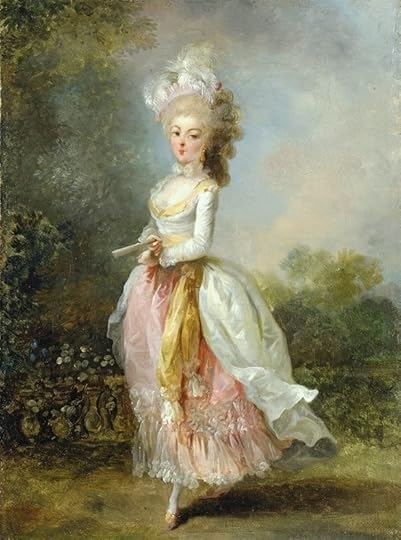 Wealthy and leisured...but at what price? In the upper classes there the prevailing attitude was of men ‘owning’ women – almost as though the men were intimidated and needed to keep women firmly under the thumb! Men subjugated women by linking learning, knowledge, politics and career to a loss of feminine charm. A ‘honey trap’ was created where a woman looked to marriage for security, and if she tried to be independent she was labelled as having loose morals. This is illustrated in this quote written in 1757 by Jean Jacques Rousseau: “there are no good morals for women outside of a withdrawn and domestic life …any woman who shows herself off disgraces herself.”
Wealthy and leisured...but at what price? In the upper classes there the prevailing attitude was of men ‘owning’ women – almost as though the men were intimidated and needed to keep women firmly under the thumb! Men subjugated women by linking learning, knowledge, politics and career to a loss of feminine charm. A ‘honey trap’ was created where a woman looked to marriage for security, and if she tried to be independent she was labelled as having loose morals. This is illustrated in this quote written in 1757 by Jean Jacques Rousseau: “there are no good morals for women outside of a withdrawn and domestic life …any woman who shows herself off disgraces herself.”
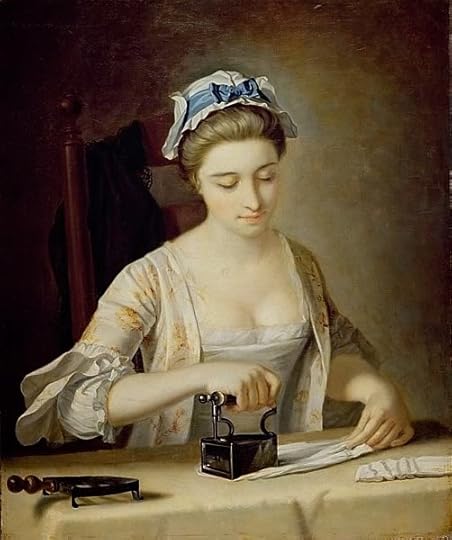 A laundress at work - one of the few 'honest' occupations
A laundress at work - one of the few 'honest' occupations
open to women
But of course, many lower class women had no choice but to earn a living and there were few jobs were considered 'decent' - and surprise, surprise, they paid poorly. Interestingly, the 18th century saw the birth of consumerism and some women stepped into roles as seamstresses (helping the wealthy keep up with the latest fashion), writing for magazines and pamphlets (more lofty literary ambition was frowned upon), decorating ceramics and indeed, serving in the new shops. But as for actresses and singers, those females who might consider entertaining for a living were labeled as being sexually available…
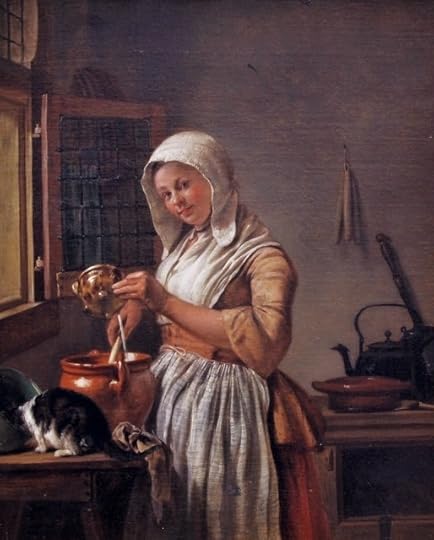 A maid at work.My latest release, The Ringmaster's Daughter, features a heroine, Henrietta Hart, a performer, who has to balance entertaining men without compromising her morals. This is easier said than done, especially when her livelihood depends on pleasing the amorous Lord Fordyce....
A maid at work.My latest release, The Ringmaster's Daughter, features a heroine, Henrietta Hart, a performer, who has to balance entertaining men without compromising her morals. This is easier said than done, especially when her livelihood depends on pleasing the amorous Lord Fordyce....
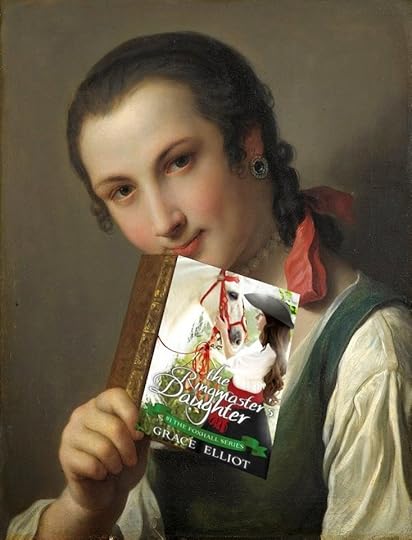
 A woman's role was to marry and have children.
A woman's role was to marry and have children.
The above quote is from the 17thcentury, but the underlying sentiment remains true a century later in Georgian times. Just in case the word ‘paradise’ confuses you – consider that women are being put in the same category as horses, that is, both subject to men, their lord and master. In effect Burton is saying that women should consider themselves jolly lucky to be coddled and generously looked after by their menfolk. Puts a different complexion on the term ‘paradise’ doesn’t it? If you aren’t convinced, then consider this quote by Judge Buller, in 1782, who ruled on a point of English law concerning women and concluded: “[It is] perfectly legal for a man to beat his wife, as long as he used a stick no thicker than his thumb.”
 Wealthy and leisured...but at what price? In the upper classes there the prevailing attitude was of men ‘owning’ women – almost as though the men were intimidated and needed to keep women firmly under the thumb! Men subjugated women by linking learning, knowledge, politics and career to a loss of feminine charm. A ‘honey trap’ was created where a woman looked to marriage for security, and if she tried to be independent she was labelled as having loose morals. This is illustrated in this quote written in 1757 by Jean Jacques Rousseau: “there are no good morals for women outside of a withdrawn and domestic life …any woman who shows herself off disgraces herself.”
Wealthy and leisured...but at what price? In the upper classes there the prevailing attitude was of men ‘owning’ women – almost as though the men were intimidated and needed to keep women firmly under the thumb! Men subjugated women by linking learning, knowledge, politics and career to a loss of feminine charm. A ‘honey trap’ was created where a woman looked to marriage for security, and if she tried to be independent she was labelled as having loose morals. This is illustrated in this quote written in 1757 by Jean Jacques Rousseau: “there are no good morals for women outside of a withdrawn and domestic life …any woman who shows herself off disgraces herself.”
 A laundress at work - one of the few 'honest' occupations
A laundress at work - one of the few 'honest' occupationsopen to women
But of course, many lower class women had no choice but to earn a living and there were few jobs were considered 'decent' - and surprise, surprise, they paid poorly. Interestingly, the 18th century saw the birth of consumerism and some women stepped into roles as seamstresses (helping the wealthy keep up with the latest fashion), writing for magazines and pamphlets (more lofty literary ambition was frowned upon), decorating ceramics and indeed, serving in the new shops. But as for actresses and singers, those females who might consider entertaining for a living were labeled as being sexually available…
 A maid at work.My latest release, The Ringmaster's Daughter, features a heroine, Henrietta Hart, a performer, who has to balance entertaining men without compromising her morals. This is easier said than done, especially when her livelihood depends on pleasing the amorous Lord Fordyce....
A maid at work.My latest release, The Ringmaster's Daughter, features a heroine, Henrietta Hart, a performer, who has to balance entertaining men without compromising her morals. This is easier said than done, especially when her livelihood depends on pleasing the amorous Lord Fordyce....
Published on May 07, 2014 06:43
April 30, 2014
Georgian Gambling: Loaded Dice
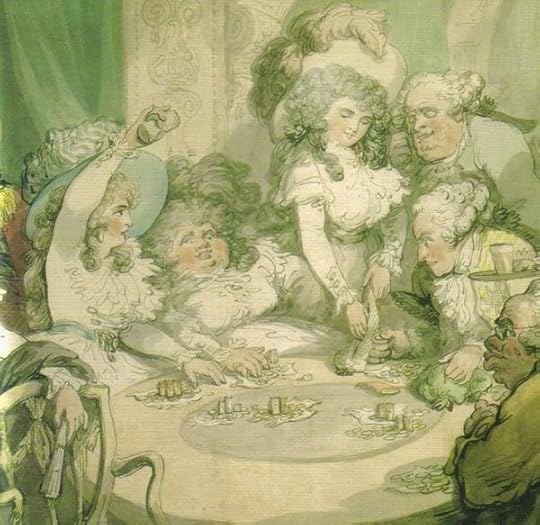 Thomas Rowlandson: 'A Gambling Table at Cavendish House'‘A thousand meadows and cornfields are staked at every throw, and as many villages lost as in the earthquake that overwhelmed Herculaneum and Pompeii.’Horace Walpole.
Thomas Rowlandson: 'A Gambling Table at Cavendish House'‘A thousand meadows and cornfields are staked at every throw, and as many villages lost as in the earthquake that overwhelmed Herculaneum and Pompeii.’Horace Walpole. The Georgian era heralded many changes in society, including the blossoming of leisure activities. It was an era when the aristocracy liked to show off their wealth, to entertain and hold house parties. At the latter, card games were especially popular and the host would set up tables for guests to play faro, quadrille, piquet or whist. But where there was gaming, there were wagers to be made, and money to be won or lost. For those less scrupulous members of society, cheating was one option to get-rich-quick.
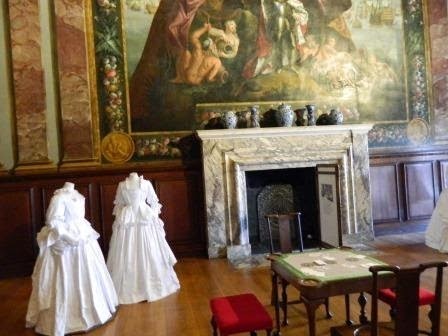 The Drawing Room in the Queen's State Apartments,
The Drawing Room in the Queen's State Apartments,Hampton Court Palace.
Note the gaming table on the rightDice were an integral part of many games, and key to cheating. Most of us have heard the expression, ‘loaded dice’, meaning that the dice have been tampered with so as to land a specific way up. Also known as ‘gourds’, these were altered dice were the stock in hand of cardsharps or ‘blacklegs’ (more them in another post.)
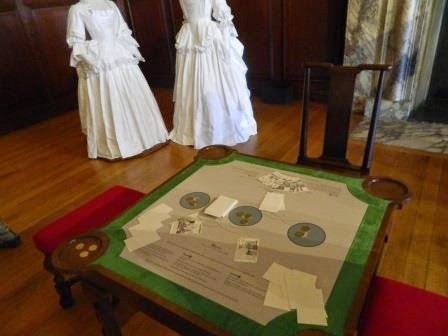
To make a gourd, a die was partially hollowed out and mercury added, so that when thrown, the die favored either low, or high, numbers. Dice that always threw a low number were known as low-fullams, and those high, as high-fullams. The latter term goes back to Elizabethan times and the London suburb of Fulham, where all the most notorious cardsharps liked to gather.
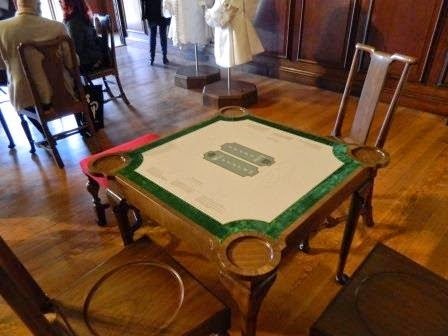 A Georgian gaming tableAnother method of cheating was with bristle-dice. These involved making a die with a short, firm bristle in one corner, such that when the die was thrown, it couldn’t settle on that corner and tip over. The technique is described in some detail, but Charles Cotton, in The Complete Gamester (1726)
A Georgian gaming tableAnother method of cheating was with bristle-dice. These involved making a die with a short, firm bristle in one corner, such that when the die was thrown, it couldn’t settle on that corner and tip over. The technique is described in some detail, but Charles Cotton, in The Complete Gamester (1726)‘By Bristle-Dice, which are fitted for that purpose, by sticking a hog’s bristle so in the corners, or otherwise in the Dice, that they shall run high or low as they please; this Bristle must be stonrg and short, by which means the Bristle bending, it will not lie of that side, but will be tript over.’
 Are black cats unlucky?
Are black cats unlucky?That'a a whole different blog post!
Published on April 30, 2014 07:48
April 23, 2014
Henry VIII or George I : Who Dined With More Style?
To celebrate 300 years since George I acceded to the throne of England, the Queen’s Chambers, Hampton Court Palace, have been opened to the public. I was particularly struck by the dining room, where King George I dined alone, but with an audience watching his every move – Somewhat reminiscent of a chimps tea-party!
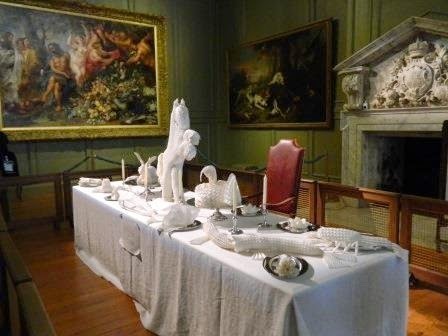 A table set for one - King George I dines before an audience
A table set for one - King George I dines before an audience
at Hampton Court PalaceThis in sharp contrast to the Great Hall, where Henry VIII presided at the top table, over what must have been boisterous and rowdy mealtimes.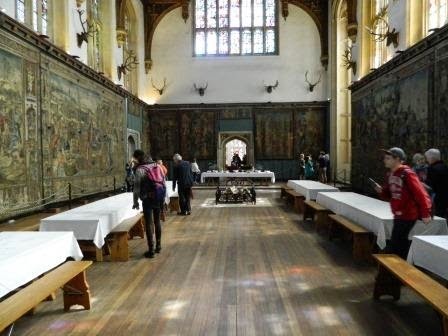 In contrast, Henry VIII sat at the top table in
In contrast, Henry VIII sat at the top table in
the Great Hall, at Hampton Court.‘Banketynge Braynlesse’The excess of Henry VIII’s banquets and feasts are legend. In an earlier post we looked at the Tudor kitchens at Hampton Court Palace, and the industry required to produce such feasts. From the perspective of the 21stcentury, we get the impression of a feast being a cross between binge drinking and a brawl, but the impression Henry had poor table manners is erroneous. A Tudor saying advises, ‘leaving one’s manners at the table’ – but here ‘manners’ refers to the left-over food, which would be fed to the poor waiting at the gate.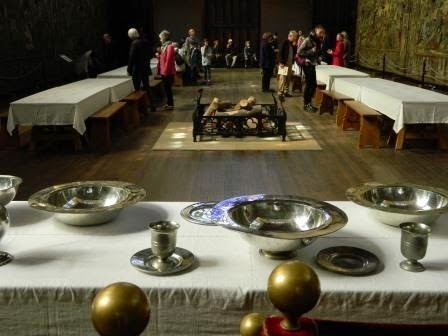 King Henry's view, watching over proceedings Indeed, in Babee’s Book (1475) of sage advice to those wishing to dine at court:Wash your hands before you eatDon’t let children linger at the tableDon’t fartDon’t pick your nose, your teeth or any part of your body whilst at the table,Don’t wipe your hands on the tablecloth or your clothes.Perhaps Henry used these occaisions to watch the factions at court, or listen for gossip, but whatever his motivation, he was frequently at the centre of things when it came to eating in public.
King Henry's view, watching over proceedings Indeed, in Babee’s Book (1475) of sage advice to those wishing to dine at court:Wash your hands before you eatDon’t let children linger at the tableDon’t fartDon’t pick your nose, your teeth or any part of your body whilst at the table,Don’t wipe your hands on the tablecloth or your clothes.Perhaps Henry used these occaisions to watch the factions at court, or listen for gossip, but whatever his motivation, he was frequently at the centre of things when it came to eating in public.
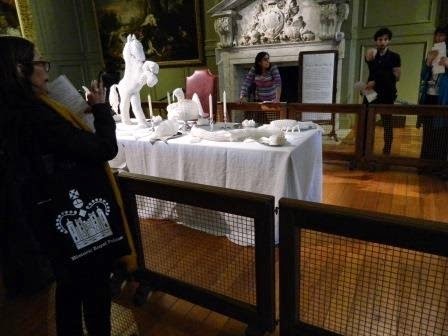 Alone, and yet surrounded by a crowd.
Alone, and yet surrounded by a crowd.
George I was the only diner, whilst the watching audience were
corralled behind a barrier.Contrast this, with King George I in the 1720’s. George was a much more private man. He preferred to dine privately but could not completely avoid the show of dining in regal splendour at a table of plenty, as previous kings had done. ‘Persons of good fashion and good appearance that have a desire to see us at dinner.’ Charles II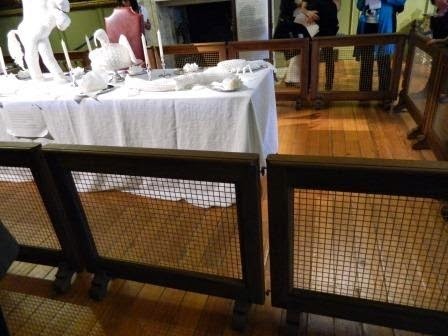 Detail of the barrier re-created by historians from the Historic Royal Palaces
Detail of the barrier re-created by historians from the Historic Royal Palaces
The desire to ogle the masticating king seems to know no bounds, and in order to contain the crowds a barrier, or rail, was erected around the royal table to confine the spectators. Even so, incidents occurred where the barrier gave way, causing injury. No records exist of exactly what these fences looked like and so the historians at Hampton Court Palace have used contemporaneous sources to re-create the barriers.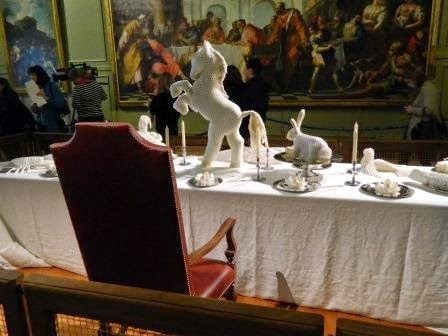 The view from George's chairWhat George I hadn’t grasped, was the importance of royal feasts and entertaining as a means of drumming up support. George didn’t get on with his son and heir, the Prince of Wales, and in a battle of popularity, the future George II hosted feasts and made his table a place of entertainment and influence. The son’s popularity then dangerously eclipsed the father’s, who had his hand forced into more public revelry than he felt comfortable with.
The view from George's chairWhat George I hadn’t grasped, was the importance of royal feasts and entertaining as a means of drumming up support. George didn’t get on with his son and heir, the Prince of Wales, and in a battle of popularity, the future George II hosted feasts and made his table a place of entertainment and influence. The son’s popularity then dangerously eclipsed the father’s, who had his hand forced into more public revelry than he felt comfortable with.
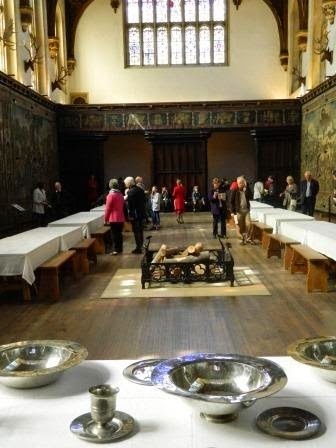 Dine with Henry or George?
Dine with Henry or George?
Which would you prefer?Anyhow, I feel sure you will agree that royal dining at Hampton Court was a sight to be seen. Which do you prefer? George's refined luxury or Henry's boisterous opulence? Do comment and tell us!
 A table set for one - King George I dines before an audience
A table set for one - King George I dines before an audienceat Hampton Court PalaceThis in sharp contrast to the Great Hall, where Henry VIII presided at the top table, over what must have been boisterous and rowdy mealtimes.
 In contrast, Henry VIII sat at the top table in
In contrast, Henry VIII sat at the top table inthe Great Hall, at Hampton Court.‘Banketynge Braynlesse’The excess of Henry VIII’s banquets and feasts are legend. In an earlier post we looked at the Tudor kitchens at Hampton Court Palace, and the industry required to produce such feasts. From the perspective of the 21stcentury, we get the impression of a feast being a cross between binge drinking and a brawl, but the impression Henry had poor table manners is erroneous. A Tudor saying advises, ‘leaving one’s manners at the table’ – but here ‘manners’ refers to the left-over food, which would be fed to the poor waiting at the gate.
 King Henry's view, watching over proceedings Indeed, in Babee’s Book (1475) of sage advice to those wishing to dine at court:Wash your hands before you eatDon’t let children linger at the tableDon’t fartDon’t pick your nose, your teeth or any part of your body whilst at the table,Don’t wipe your hands on the tablecloth or your clothes.Perhaps Henry used these occaisions to watch the factions at court, or listen for gossip, but whatever his motivation, he was frequently at the centre of things when it came to eating in public.
King Henry's view, watching over proceedings Indeed, in Babee’s Book (1475) of sage advice to those wishing to dine at court:Wash your hands before you eatDon’t let children linger at the tableDon’t fartDon’t pick your nose, your teeth or any part of your body whilst at the table,Don’t wipe your hands on the tablecloth or your clothes.Perhaps Henry used these occaisions to watch the factions at court, or listen for gossip, but whatever his motivation, he was frequently at the centre of things when it came to eating in public.
 Alone, and yet surrounded by a crowd.
Alone, and yet surrounded by a crowd.George I was the only diner, whilst the watching audience were
corralled behind a barrier.Contrast this, with King George I in the 1720’s. George was a much more private man. He preferred to dine privately but could not completely avoid the show of dining in regal splendour at a table of plenty, as previous kings had done. ‘Persons of good fashion and good appearance that have a desire to see us at dinner.’ Charles II
 Detail of the barrier re-created by historians from the Historic Royal Palaces
Detail of the barrier re-created by historians from the Historic Royal Palaces
The desire to ogle the masticating king seems to know no bounds, and in order to contain the crowds a barrier, or rail, was erected around the royal table to confine the spectators. Even so, incidents occurred where the barrier gave way, causing injury. No records exist of exactly what these fences looked like and so the historians at Hampton Court Palace have used contemporaneous sources to re-create the barriers.
 The view from George's chairWhat George I hadn’t grasped, was the importance of royal feasts and entertaining as a means of drumming up support. George didn’t get on with his son and heir, the Prince of Wales, and in a battle of popularity, the future George II hosted feasts and made his table a place of entertainment and influence. The son’s popularity then dangerously eclipsed the father’s, who had his hand forced into more public revelry than he felt comfortable with.
The view from George's chairWhat George I hadn’t grasped, was the importance of royal feasts and entertaining as a means of drumming up support. George didn’t get on with his son and heir, the Prince of Wales, and in a battle of popularity, the future George II hosted feasts and made his table a place of entertainment and influence. The son’s popularity then dangerously eclipsed the father’s, who had his hand forced into more public revelry than he felt comfortable with.
 Dine with Henry or George?
Dine with Henry or George?Which would you prefer?Anyhow, I feel sure you will agree that royal dining at Hampton Court was a sight to be seen. Which do you prefer? George's refined luxury or Henry's boisterous opulence? Do comment and tell us!
Published on April 23, 2014 01:15
April 16, 2014
A Visit to the Georgian Court at Hampton Court Palace
The Georgians have arrived!
It is nearly 300 years since an obscure German prince, acceded to the English throne. As part of a raft of events to celebrate the start of this fascinating period in history, the clever people at Hampton Court Palace, have re-created what it was like to visit the Georgian court.
I was thrilled to be invited by the Historic Royal Palaces (the guardians of HCP) to preview the rooms, before they open to the public this Easter weekend. Within the Georgian court there were too many interesting stories to cover in one post, so let me start this week, with a tour of the rooms.
Let's pretend you are a wealthy aristocrat, seeking to petition the King on a matter of personal importance. King George is in residence at Hampton Court Palace, so that's where you must go. As part of the court circle you are allowed into the palace, but where is the king? You are told he is in the Queen's Royal Apartments, so off you go to seek an audience.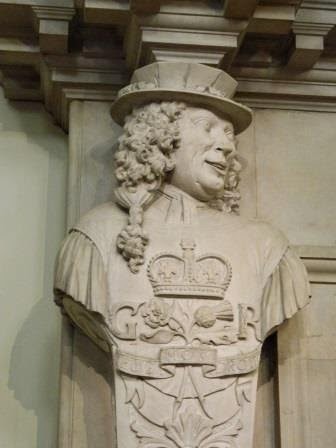 The Georgians, it seems, had a sense of humour.
The Georgians, it seems, had a sense of humour.
A smiling yeoman guard ornaments the fireplace in the
Queen's Guard Chamber.
Note the 'GR' on his livery.The portal to the royal apartments is the Queen's Guard Chamber. You knock on the door and because of your wealth and status, the Yeoman Guard allow you admittance. You enter a large room, filled with courtiers who all have the same goal, of seeing the king.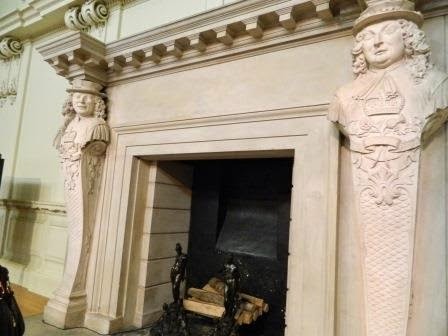 The fireplace in the Queen's Guard ChamberFortunately, you are selected to pass deeper into the apartments and are escorted into the Queen's Presence Chamber. This is another large room, this time lined with impressive portraits, including one of King George in his coronation gown, a strong reminder of his sovereign power.
The fireplace in the Queen's Guard ChamberFortunately, you are selected to pass deeper into the apartments and are escorted into the Queen's Presence Chamber. This is another large room, this time lined with impressive portraits, including one of King George in his coronation gown, a strong reminder of his sovereign power.
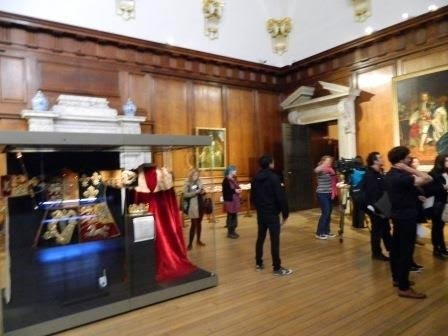 The Queen's Presence ChamberYou have arrived a short time before the king dines in public, and so you are escorted through the Dining Room. The table is set for one person - the King- and the barriers already erected to keep those watching him eat, at a distance from the royal person.
The Queen's Presence ChamberYou have arrived a short time before the king dines in public, and so you are escorted through the Dining Room. The table is set for one person - the King- and the barriers already erected to keep those watching him eat, at a distance from the royal person.
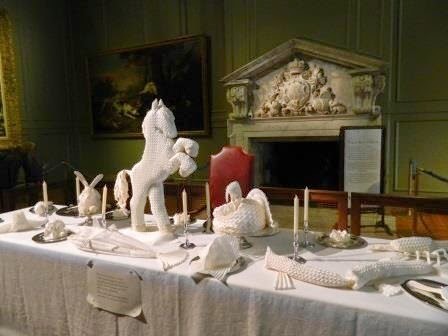 The Dining Room - set for one - the King!You are ushered through the dining area into the inner Privy Chambers. The room is packed with courtiers dressed in their finest clothes. The decor is spectacular, the paintings on the ceiling and walls designed to emphasise the new king's legitimate claim to the throne, and reinforce his stately power.
The Dining Room - set for one - the King!You are ushered through the dining area into the inner Privy Chambers. The room is packed with courtiers dressed in their finest clothes. The decor is spectacular, the paintings on the ceiling and walls designed to emphasise the new king's legitimate claim to the throne, and reinforce his stately power.
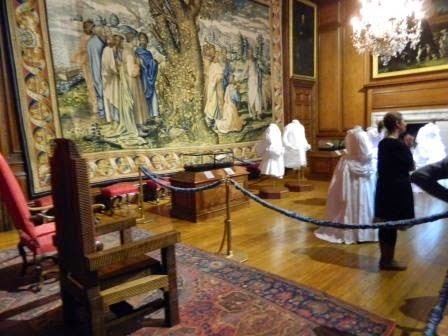 The Privy Chamber - the King would receive petitioners whilst seated
The Privy Chamber - the King would receive petitioners whilst seated
in one of the chairs to the left of the picture.However, your petition is of a more personal nature and so you are one of the favoured few who transit into the Drawing Room. This is a more intimate place, where the royal family can relax and play cards, or gamble, with their favourite courtiers.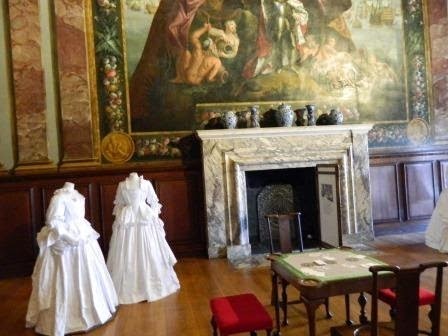 The Drawing Room - set with tables at which guests could play
The Drawing Room - set with tables at which guests could play
card gamesBut today, the King is not in the Drawing Room, but next door in the State Bedchamber. This is where the monarch, whilst he is being ritually dressed, receives visitors and starts the business of the day.
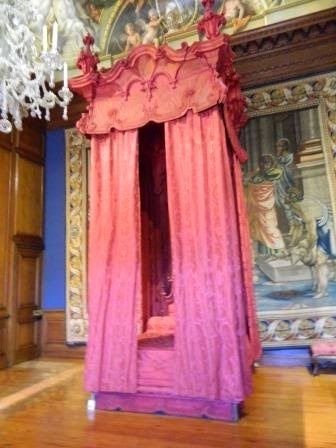 The State Bedchamber -
The State Bedchamber -
The bed is hung with original draperyBut you are sent beyond the State Bedchamber, into the private rooms and beyond into the Gallery.On wet days, should the King wish to exercise, he can promenade, or play sports, in this long gallery. You catch up with the King here, and he is in a generous mood, and suggests you speak to one of his retinue who can be found in the private chambers.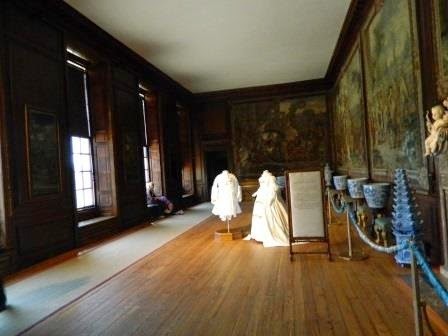 The Gallery - a lovely place to promenade and take exercise on a wet day.Your mission continues as you visit the room belonging to the Women of the Queen's Bedchamber, and pass on into the Queen's Bedchamber itself. Since King George's wife is absent (that's a whole new story) pass through and into her Dressing Room, then into her private Oratory.
The Gallery - a lovely place to promenade and take exercise on a wet day.Your mission continues as you visit the room belonging to the Women of the Queen's Bedchamber, and pass on into the Queen's Bedchamber itself. Since King George's wife is absent (that's a whole new story) pass through and into her Dressing Room, then into her private Oratory.
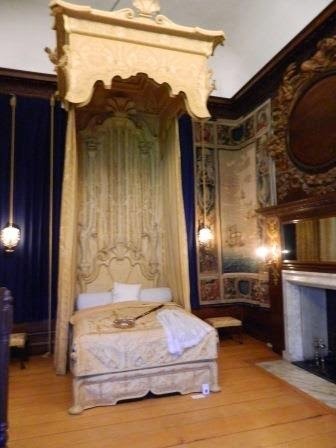 The Queen's Private Bedchamber -
The Queen's Private Bedchamber -
where she sought a little privacy.Hey ho, the man you needed to speak to is not there, so you are escorted back out into the corridor, and find you have travelled full circle.
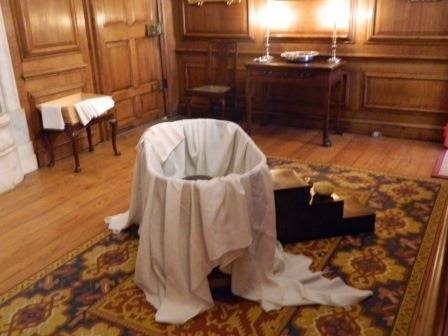 Next door to the Queen's Bedchamber is the room where she
Next door to the Queen's Bedchamber is the room where she
takes her bath.. Hey ho! It seems you have had a wasted trip, but at least you saw the sights on the way round.
If you would like to visit the Georgian Chambers at Hampton Court Palace - just click the links.
Next week: Dining: Henry VIII vs George I
It is nearly 300 years since an obscure German prince, acceded to the English throne. As part of a raft of events to celebrate the start of this fascinating period in history, the clever people at Hampton Court Palace, have re-created what it was like to visit the Georgian court.

I was thrilled to be invited by the Historic Royal Palaces (the guardians of HCP) to preview the rooms, before they open to the public this Easter weekend. Within the Georgian court there were too many interesting stories to cover in one post, so let me start this week, with a tour of the rooms.
Let's pretend you are a wealthy aristocrat, seeking to petition the King on a matter of personal importance. King George is in residence at Hampton Court Palace, so that's where you must go. As part of the court circle you are allowed into the palace, but where is the king? You are told he is in the Queen's Royal Apartments, so off you go to seek an audience.
 The Georgians, it seems, had a sense of humour.
The Georgians, it seems, had a sense of humour.A smiling yeoman guard ornaments the fireplace in the
Queen's Guard Chamber.
Note the 'GR' on his livery.The portal to the royal apartments is the Queen's Guard Chamber. You knock on the door and because of your wealth and status, the Yeoman Guard allow you admittance. You enter a large room, filled with courtiers who all have the same goal, of seeing the king.
 The fireplace in the Queen's Guard ChamberFortunately, you are selected to pass deeper into the apartments and are escorted into the Queen's Presence Chamber. This is another large room, this time lined with impressive portraits, including one of King George in his coronation gown, a strong reminder of his sovereign power.
The fireplace in the Queen's Guard ChamberFortunately, you are selected to pass deeper into the apartments and are escorted into the Queen's Presence Chamber. This is another large room, this time lined with impressive portraits, including one of King George in his coronation gown, a strong reminder of his sovereign power.
 The Queen's Presence ChamberYou have arrived a short time before the king dines in public, and so you are escorted through the Dining Room. The table is set for one person - the King- and the barriers already erected to keep those watching him eat, at a distance from the royal person.
The Queen's Presence ChamberYou have arrived a short time before the king dines in public, and so you are escorted through the Dining Room. The table is set for one person - the King- and the barriers already erected to keep those watching him eat, at a distance from the royal person.
 The Dining Room - set for one - the King!You are ushered through the dining area into the inner Privy Chambers. The room is packed with courtiers dressed in their finest clothes. The decor is spectacular, the paintings on the ceiling and walls designed to emphasise the new king's legitimate claim to the throne, and reinforce his stately power.
The Dining Room - set for one - the King!You are ushered through the dining area into the inner Privy Chambers. The room is packed with courtiers dressed in their finest clothes. The decor is spectacular, the paintings on the ceiling and walls designed to emphasise the new king's legitimate claim to the throne, and reinforce his stately power. The Privy Chamber - the King would receive petitioners whilst seated
The Privy Chamber - the King would receive petitioners whilst seatedin one of the chairs to the left of the picture.However, your petition is of a more personal nature and so you are one of the favoured few who transit into the Drawing Room. This is a more intimate place, where the royal family can relax and play cards, or gamble, with their favourite courtiers.
 The Drawing Room - set with tables at which guests could play
The Drawing Room - set with tables at which guests could playcard gamesBut today, the King is not in the Drawing Room, but next door in the State Bedchamber. This is where the monarch, whilst he is being ritually dressed, receives visitors and starts the business of the day.
 The State Bedchamber -
The State Bedchamber -The bed is hung with original draperyBut you are sent beyond the State Bedchamber, into the private rooms and beyond into the Gallery.On wet days, should the King wish to exercise, he can promenade, or play sports, in this long gallery. You catch up with the King here, and he is in a generous mood, and suggests you speak to one of his retinue who can be found in the private chambers.
 The Gallery - a lovely place to promenade and take exercise on a wet day.Your mission continues as you visit the room belonging to the Women of the Queen's Bedchamber, and pass on into the Queen's Bedchamber itself. Since King George's wife is absent (that's a whole new story) pass through and into her Dressing Room, then into her private Oratory.
The Gallery - a lovely place to promenade and take exercise on a wet day.Your mission continues as you visit the room belonging to the Women of the Queen's Bedchamber, and pass on into the Queen's Bedchamber itself. Since King George's wife is absent (that's a whole new story) pass through and into her Dressing Room, then into her private Oratory.
 The Queen's Private Bedchamber -
The Queen's Private Bedchamber -where she sought a little privacy.Hey ho, the man you needed to speak to is not there, so you are escorted back out into the corridor, and find you have travelled full circle.
 Next door to the Queen's Bedchamber is the room where she
Next door to the Queen's Bedchamber is the room where shetakes her bath.. Hey ho! It seems you have had a wasted trip, but at least you saw the sights on the way round.
If you would like to visit the Georgian Chambers at Hampton Court Palace - just click the links.
Next week: Dining: Henry VIII vs George I
Published on April 16, 2014 04:40
April 9, 2014
Mary, Queen of Scots, and her Dogs
 Mary, Queen of ScotsMary, Queen of Scots, was born in 1542, during the reign of King Henry VIII. She led a turbulent life of which the most constant factor was her loves of dogs, specifically Maltese terriers. These small, white dogs were her constant companions from infancy to the scaffold and this is their story.As a 5 year old child, Mary was betrothed to French dauphin, Francis, and sent to live with him abroad. Uprooted, disorientated, and unable to speak French, Mary would only talk to her Scottish governess or one of the twenty-two dogs at Francis’s court. Mary confided in those dogs, a collection of pugs, spaniels and Maltese terriers, and in turn, Francis used them to teach his bride the French language. Her early love of dogs was established.
Mary, Queen of ScotsMary, Queen of Scots, was born in 1542, during the reign of King Henry VIII. She led a turbulent life of which the most constant factor was her loves of dogs, specifically Maltese terriers. These small, white dogs were her constant companions from infancy to the scaffold and this is their story.As a 5 year old child, Mary was betrothed to French dauphin, Francis, and sent to live with him abroad. Uprooted, disorientated, and unable to speak French, Mary would only talk to her Scottish governess or one of the twenty-two dogs at Francis’s court. Mary confided in those dogs, a collection of pugs, spaniels and Maltese terriers, and in turn, Francis used them to teach his bride the French language. Her early love of dogs was established.
 Francis, with Mary. King and Queen of France.When she was just 18, Francis died, leaving Mary a widow in a foreign country. Devastated by the loss of the husband she had grown to love, she returned to Scotland to reclaim her throne. She took with her some of her favorite Maltese dogs. But things were very different from when she left as a child. Scotland had become a Protestant country, and Mary was a devote Catholic. Queen Elizabeth I sat on the English throne and was deeply suspicious of her cousin, Mary’s motives. Added to that Mary unwisely married another Tudor, her cousin, Lord Darnley, which put further pressure on Elizabeth to recognize Mary as successor to the English throne.
Francis, with Mary. King and Queen of France.When she was just 18, Francis died, leaving Mary a widow in a foreign country. Devastated by the loss of the husband she had grown to love, she returned to Scotland to reclaim her throne. She took with her some of her favorite Maltese dogs. But things were very different from when she left as a child. Scotland had become a Protestant country, and Mary was a devote Catholic. Queen Elizabeth I sat on the English throne and was deeply suspicious of her cousin, Mary’s motives. Added to that Mary unwisely married another Tudor, her cousin, Lord Darnley, which put further pressure on Elizabeth to recognize Mary as successor to the English throne.
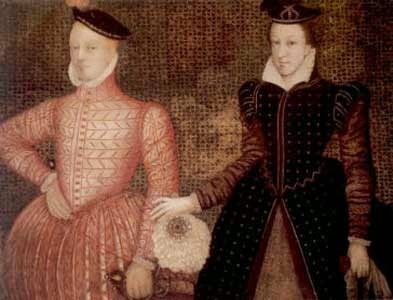 Mary and DarnleyDarnley, however, turned out to be a brute, and Mary feared for her life. When he died under suspicious circumstances the finger was pointed at Mary and her lover, the Earl of Bothwell. This murder enraged the Scottish nobility and population in general, and Mary was forced to abdicate in favor of her baby son with Darnley, James (later James I of England).Mary eventually fled over the border to seek the protection of her English cousin, Elizabeth. But Queen Elizabeth could not ignore the scandal dogging Mary’s heels and imprisoned her. It was politically expedient to keep the former queen safely under lock and key, and for 18 years Elizabeth kept Mary a prisoner.
Mary and DarnleyDarnley, however, turned out to be a brute, and Mary feared for her life. When he died under suspicious circumstances the finger was pointed at Mary and her lover, the Earl of Bothwell. This murder enraged the Scottish nobility and population in general, and Mary was forced to abdicate in favor of her baby son with Darnley, James (later James I of England).Mary eventually fled over the border to seek the protection of her English cousin, Elizabeth. But Queen Elizabeth could not ignore the scandal dogging Mary’s heels and imprisoned her. It was politically expedient to keep the former queen safely under lock and key, and for 18 years Elizabeth kept Mary a prisoner.
 A Maltese TerrierWhilst in prison, Mary was not allowed contact with friends or relatives, for fear of her plotting against the queen. Her only companions and source of comfort were her Maltese lapdogs. Her jailor, Bess of Hardwick, reported her charge spending hours talking to these dogs; about her estranged son, James, and religion. Mary even sent a portrait of one of her favorite dogs to James – but the picture was intercepted and never reached him. Things went from bad to worse for Mary, when she was charged with being an accomplice in the 1586 plot to murder Queen Elizabeth, (Mary would have been next in line for the throne.) Mary was moved to Fotheringhay Castle and brought to trial. She was found guilty and sentenced to death by beheading. Fotheringhay was a damp, dark, miserable place and her only comfort were her lapdogs – after she appealed directly to Elizabeth in order to keep them with her.
A Maltese TerrierWhilst in prison, Mary was not allowed contact with friends or relatives, for fear of her plotting against the queen. Her only companions and source of comfort were her Maltese lapdogs. Her jailor, Bess of Hardwick, reported her charge spending hours talking to these dogs; about her estranged son, James, and religion. Mary even sent a portrait of one of her favorite dogs to James – but the picture was intercepted and never reached him. Things went from bad to worse for Mary, when she was charged with being an accomplice in the 1586 plot to murder Queen Elizabeth, (Mary would have been next in line for the throne.) Mary was moved to Fotheringhay Castle and brought to trial. She was found guilty and sentenced to death by beheading. Fotheringhay was a damp, dark, miserable place and her only comfort were her lapdogs – after she appealed directly to Elizabeth in order to keep them with her.
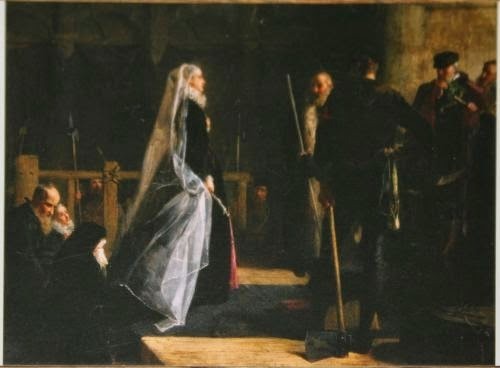 Mary walking to the scaffold.As Mary took her final walk to the scaffold, she moved slowly in order to keep pace with a small white dog concealed beneath her skirts and petticoats. No one realized the dog was there, until after Mary’s death when the executioner, Mr Bull, was removing the body. The dog refused to leave the corpse and had to be forcibly removed, where upon he ran back and settled between the severed head and shoulders.Mr Bull had orders to wash or burn anything that was soiled with Mary’s blood, “for fear someone might dip a piece of linen in it…who keep it as a relic of this act[execution], to incite to vengeance those concerned for the death of the dead person.”
Mary walking to the scaffold.As Mary took her final walk to the scaffold, she moved slowly in order to keep pace with a small white dog concealed beneath her skirts and petticoats. No one realized the dog was there, until after Mary’s death when the executioner, Mr Bull, was removing the body. The dog refused to leave the corpse and had to be forcibly removed, where upon he ran back and settled between the severed head and shoulders.Mr Bull had orders to wash or burn anything that was soiled with Mary’s blood, “for fear someone might dip a piece of linen in it…who keep it as a relic of this act[execution], to incite to vengeance those concerned for the death of the dead person.”The white dog was now covered in blood, but Mr Bull acted kindly and had him washed clean. The dog was then given to a French princess, on the condition that he left the country.

Published on April 09, 2014 01:31
April 3, 2014
Guest Author, Regan Walker : The Ship's Cat
The Ship’s Catby Regan Walker
http://www.reganwalkerauthor.com
What’s a ship without a ship’s cat, right? So, of course, my latest Regency WIND RAVEN, a pirate adventure set on a schooner (and other places) in 1817, had to have a cat. And it had to be a special cat.

It probably seems fundamental that a cat could be, and was, a valued member of the crew, particularly for ridding a ship of mice and rats. In addition to cats, sailors in the 18th and 19th centuries kept a plethora of animals as pets, anything they took a fancy to and could buy in any foreign port they happened to visit. No doubt such pets offered the seamen who were away from their homes for long periods a companionship the longed for. Of course, some of these pets ended up dying from lack of their normal diets, but that didn't stop the sailors from bringing them aboard. And there were other problems. Back then, no one spayed or neutered cats so a female cat might produce a litter from a shore leave liaison. Then, too, a shipboard tomcat would be inclined to spray urine, which probably added to the general scent belowdecks. That is one reason the cat in my story is a female!
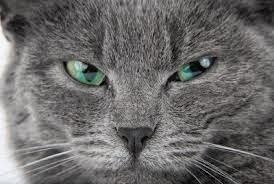
Cats being cats, there were probably ship's cats that were aloof and half-feral, and then there were other ship's cats that were social lap-cats. The cat in WIND RAVEN is somewhere in between. Named “Dutch Sam’ for the English boxer Samuel Elias, who died the year before my story begins, and who was known as having the deadliest fists of any boxer in London, my ship’s cat has two huge white paws (with extra toes, don’t you know!). The crew of the Wind Raven thought it a fitting tribute to name their unusual after the boxer they revered.
Did you know that sailors believed that cats had an influence on the weather? Some believed these cats could start storms through magic stored in their tails. If a ship's cat fell or was thrown overboard, it was thought that it would summon a terrible storm to sink the ship and that if the ship was able to survive, it would be cursed with nine years of bad luck. Other beliefs included: if a cat licked its fur against the grain, it meant a hailstorm was coming; if it sneezed it meant rain; and if it was frisky it meant wind. Some of these beliefs are rooted in reality. Cats are able to detect slight changes in the weather as a result of their very sensitive inner ears, the same characteristic that allows them to land upright when falling. Low atmospheric pressure, a common precursor of stormy weather, often makes cats nervous and restless.

Traditionally the ship's cat was allowed to come and go at will when the ship was in port. If the cat was not aboard when the ship sailed, it might be there the next time the ship was back in port. After all, there are always plenty of rodents and garbage along the waterfront for the cats to survive in between ships. For an independent cat like Dutch Sam, the arrangement was perfect, and she promptly attached herself to the Captain Nicholas Powell, the hero in my story, following him back to his ship when it was in port in St. Thomas. Of course, during the story, her attachment to the heroine grows and she begins to take naps in the heroine’s cabin.
There are many famous ship’s cats, but perhaps my favorite is Blackie and that’s because of the man he impressed enough to set aside the cares of a world war to greet him. A man who impressed me enough to name my son after him. Blackie was the ship’s cat on the HMS Prince of Wales during the Second World War when the ship carried Prime Minister Winston Churchill across the Atlantic to Newfoundland in 1941, where he secretly met with the American President. As Churchill prepared to step off the Prince of Wales, Blackie (obviously recognizing a man worthy of his attention) approached Churchill. And, Churchill (obviously recognizing a discerning cat) stooped to bid the cat farewell. The moment was captured on camera and reported around the world.

In honor of the encounter, Blackie’s name was changed to “Churchill.’ Churchill was known to love cats and kept a succession of them at Chartwell, his home. His best-known cat during the war years was a big gray cat named “Nelson’ after England’s famous admiral. How wonderful is that? Click for link Ordered by the Prince Regent into the Caribbean, English sea captain and former privateer Jean Nicholas Powell has no time for women onboard the Wind Raven, especially not Tara McConnell. The impudent American forced herself aboard, and so she’ll get more than she bargained for: Instead of a direct sail to Baltimore, she’ll join their quest to investigate a rampaging pirate, the infamous Roberto Cofresi.But the hoyden thinks she can crew with his men, and though he bans her from the rigging, Nick is captivated watching her lithe, luscious movements on deck. Facing high seas, storms, cutthroats and the endless unknown, he must protect his ship, his passenger, his crew. But on this voyage, with this woman, there is a greater danger: to his heart.
Click for link Ordered by the Prince Regent into the Caribbean, English sea captain and former privateer Jean Nicholas Powell has no time for women onboard the Wind Raven, especially not Tara McConnell. The impudent American forced herself aboard, and so she’ll get more than she bargained for: Instead of a direct sail to Baltimore, she’ll join their quest to investigate a rampaging pirate, the infamous Roberto Cofresi.But the hoyden thinks she can crew with his men, and though he bans her from the rigging, Nick is captivated watching her lithe, luscious movements on deck. Facing high seas, storms, cutthroats and the endless unknown, he must protect his ship, his passenger, his crew. But on this voyage, with this woman, there is a greater danger: to his heart.
Excerpt – WIND RAVEN – The Storm begins
“You wished to speak to me, Captain?” Tara tried to remain calm, but being alone with the man who had kissed her twice was, to say the least, disconcerting. She tried not to look at his bed. He leaned against his desk, crossing one booted foot over the other. The sight of his black hair tousled by the wind and his golden eyes framed by his dark eyebrows scattered her thoughts.
“I want you below decks and in your cabin when the storm hits, Miss McConnell. You might even want to tie yourself to the bed so you’re not tossed to the deck. It’s going to be rough.”
“This isn’t my first storm, Captain.” Surely the man must know by now that she could pull her own weight with the crew.
“Perhaps not, but it’s your first storm aboard my ship, and I’ll not be taking any chances with your safety. Is that clear?”
“Perfectly.” He was staring at her as if he wanted to say something more but then shrugged and pushed away from his desk. A sudden lurch of the ship brought her careening into his chest. He steadied her with his hands on her upper arms and, for a moment, stared into her eyes, then at her lips.
Instead of letting her go, he drew her more tightly against his chest, his golden eyes boring into hers. “I don’t seem to be able to resist you this close, Miss McConnell.” She felt the heat between them as he bent his head and kissed her, a kiss as fierce as the storm she knew was fast approaching. Her body seemed to come alive as his arms held her. His lips lifted from hers.
“I wish I had time to show you more, but right now my ship requires my attention.” He set her away from him and, reaching for a chart from his desk, swept up the rolled document and strode from the cabin as if the ship wasn’t rolling beneath his feet.
Tara gripped the edge of his desk to steady herself, and not just because of the swells that had the ship constantly dipping and lunging. Damn the unmitigated gall of the man! What made him think he could kiss her whenever he wanted? More troublesome still, why had she let him?
Wind Raven - Nook
Wind Raven - Amazon
You can find out more about Regan and her wonderful books here:
Regan's links:Website: http://www.reganwalkerauthor.com/Blog: http://reganromancereview.blogspot.com/Twitter: @RegansReview (https://twitter.com/RegansReview)Facebook: http://www.facebook.com/regan.walker.104
Goodreads: http://www.goodreads.com/author/show/6450403.Regan_Walker
What’s a ship without a ship’s cat, right? So, of course, my latest Regency WIND RAVEN, a pirate adventure set on a schooner (and other places) in 1817, had to have a cat. And it had to be a special cat.

It probably seems fundamental that a cat could be, and was, a valued member of the crew, particularly for ridding a ship of mice and rats. In addition to cats, sailors in the 18th and 19th centuries kept a plethora of animals as pets, anything they took a fancy to and could buy in any foreign port they happened to visit. No doubt such pets offered the seamen who were away from their homes for long periods a companionship the longed for. Of course, some of these pets ended up dying from lack of their normal diets, but that didn't stop the sailors from bringing them aboard. And there were other problems. Back then, no one spayed or neutered cats so a female cat might produce a litter from a shore leave liaison. Then, too, a shipboard tomcat would be inclined to spray urine, which probably added to the general scent belowdecks. That is one reason the cat in my story is a female!

Cats being cats, there were probably ship's cats that were aloof and half-feral, and then there were other ship's cats that were social lap-cats. The cat in WIND RAVEN is somewhere in between. Named “Dutch Sam’ for the English boxer Samuel Elias, who died the year before my story begins, and who was known as having the deadliest fists of any boxer in London, my ship’s cat has two huge white paws (with extra toes, don’t you know!). The crew of the Wind Raven thought it a fitting tribute to name their unusual after the boxer they revered.
Did you know that sailors believed that cats had an influence on the weather? Some believed these cats could start storms through magic stored in their tails. If a ship's cat fell or was thrown overboard, it was thought that it would summon a terrible storm to sink the ship and that if the ship was able to survive, it would be cursed with nine years of bad luck. Other beliefs included: if a cat licked its fur against the grain, it meant a hailstorm was coming; if it sneezed it meant rain; and if it was frisky it meant wind. Some of these beliefs are rooted in reality. Cats are able to detect slight changes in the weather as a result of their very sensitive inner ears, the same characteristic that allows them to land upright when falling. Low atmospheric pressure, a common precursor of stormy weather, often makes cats nervous and restless.

Traditionally the ship's cat was allowed to come and go at will when the ship was in port. If the cat was not aboard when the ship sailed, it might be there the next time the ship was back in port. After all, there are always plenty of rodents and garbage along the waterfront for the cats to survive in between ships. For an independent cat like Dutch Sam, the arrangement was perfect, and she promptly attached herself to the Captain Nicholas Powell, the hero in my story, following him back to his ship when it was in port in St. Thomas. Of course, during the story, her attachment to the heroine grows and she begins to take naps in the heroine’s cabin.
There are many famous ship’s cats, but perhaps my favorite is Blackie and that’s because of the man he impressed enough to set aside the cares of a world war to greet him. A man who impressed me enough to name my son after him. Blackie was the ship’s cat on the HMS Prince of Wales during the Second World War when the ship carried Prime Minister Winston Churchill across the Atlantic to Newfoundland in 1941, where he secretly met with the American President. As Churchill prepared to step off the Prince of Wales, Blackie (obviously recognizing a man worthy of his attention) approached Churchill. And, Churchill (obviously recognizing a discerning cat) stooped to bid the cat farewell. The moment was captured on camera and reported around the world.

In honor of the encounter, Blackie’s name was changed to “Churchill.’ Churchill was known to love cats and kept a succession of them at Chartwell, his home. His best-known cat during the war years was a big gray cat named “Nelson’ after England’s famous admiral. How wonderful is that?
 Click for link Ordered by the Prince Regent into the Caribbean, English sea captain and former privateer Jean Nicholas Powell has no time for women onboard the Wind Raven, especially not Tara McConnell. The impudent American forced herself aboard, and so she’ll get more than she bargained for: Instead of a direct sail to Baltimore, she’ll join their quest to investigate a rampaging pirate, the infamous Roberto Cofresi.But the hoyden thinks she can crew with his men, and though he bans her from the rigging, Nick is captivated watching her lithe, luscious movements on deck. Facing high seas, storms, cutthroats and the endless unknown, he must protect his ship, his passenger, his crew. But on this voyage, with this woman, there is a greater danger: to his heart.
Click for link Ordered by the Prince Regent into the Caribbean, English sea captain and former privateer Jean Nicholas Powell has no time for women onboard the Wind Raven, especially not Tara McConnell. The impudent American forced herself aboard, and so she’ll get more than she bargained for: Instead of a direct sail to Baltimore, she’ll join their quest to investigate a rampaging pirate, the infamous Roberto Cofresi.But the hoyden thinks she can crew with his men, and though he bans her from the rigging, Nick is captivated watching her lithe, luscious movements on deck. Facing high seas, storms, cutthroats and the endless unknown, he must protect his ship, his passenger, his crew. But on this voyage, with this woman, there is a greater danger: to his heart.Excerpt – WIND RAVEN – The Storm begins
“You wished to speak to me, Captain?” Tara tried to remain calm, but being alone with the man who had kissed her twice was, to say the least, disconcerting. She tried not to look at his bed. He leaned against his desk, crossing one booted foot over the other. The sight of his black hair tousled by the wind and his golden eyes framed by his dark eyebrows scattered her thoughts.
“I want you below decks and in your cabin when the storm hits, Miss McConnell. You might even want to tie yourself to the bed so you’re not tossed to the deck. It’s going to be rough.”
“This isn’t my first storm, Captain.” Surely the man must know by now that she could pull her own weight with the crew.
“Perhaps not, but it’s your first storm aboard my ship, and I’ll not be taking any chances with your safety. Is that clear?”
“Perfectly.” He was staring at her as if he wanted to say something more but then shrugged and pushed away from his desk. A sudden lurch of the ship brought her careening into his chest. He steadied her with his hands on her upper arms and, for a moment, stared into her eyes, then at her lips.
Instead of letting her go, he drew her more tightly against his chest, his golden eyes boring into hers. “I don’t seem to be able to resist you this close, Miss McConnell.” She felt the heat between them as he bent his head and kissed her, a kiss as fierce as the storm she knew was fast approaching. Her body seemed to come alive as his arms held her. His lips lifted from hers.
“I wish I had time to show you more, but right now my ship requires my attention.” He set her away from him and, reaching for a chart from his desk, swept up the rolled document and strode from the cabin as if the ship wasn’t rolling beneath his feet.
Tara gripped the edge of his desk to steady herself, and not just because of the swells that had the ship constantly dipping and lunging. Damn the unmitigated gall of the man! What made him think he could kiss her whenever he wanted? More troublesome still, why had she let him?
Wind Raven - Nook
Wind Raven - Amazon
You can find out more about Regan and her wonderful books here:
Regan's links:Website: http://www.reganwalkerauthor.com/Blog: http://reganromancereview.blogspot.com/Twitter: @RegansReview (https://twitter.com/RegansReview)Facebook: http://www.facebook.com/regan.walker.104
Goodreads: http://www.goodreads.com/author/show/6450403.Regan_Walker
Published on April 03, 2014 13:49
Guest author Regan Walker - England's Last Revolution
I'm delighted to welcome guest author, Regan Walker, to Fall in Love with History. Regan is a fellow animal lover and has a golden retriever called, Link [I'd love to know how you came up with the name, Regan! So unusual.] Regan writes Regency romance and I can't wait to read her latest book, Against the Wind.So without further ado, here is her post on the intriguing subject of England's last revolution.
 A warm welcome to Regan WalkerEngland’s Last Revolution – When Mere Villagers Fought “Against the Wind”
A warm welcome to Regan WalkerEngland’s Last Revolution – When Mere Villagers Fought “Against the Wind”
On June 9, 1817, a group of village men from Pentrich in Derbyshire, England rose in rebellion against the Crown. Dubbed “the Last Revolution in England,” it might have more accurately been called a government-inspired provocation to action, designed to justify repression. Why did the villages fight “against the wind” that was the power of England?
After the war with France ended in 1814, England suffered from great social, economic and political problems. Many of the major issues were the direct result of the war, but others were the necessary product of the changes occurring throughout society. The discontent and the distress in the lives of the common people culminated in the series of events between 1811-1819, including the Pentrich Rebellion of 1817, which is the backdrop for my historical romance novel, Against the Wind.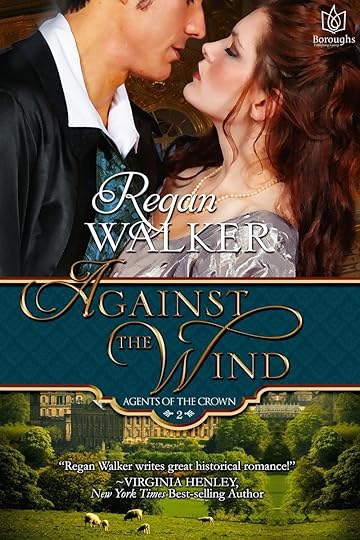 Click for buy linkThe uprising in the Midlands in 1817 was just what the leaders of the British government needed to justify sending a strong signal to the masses that no rebellion, such as occurred in the French Revolution, would be tolerated in England. The hundreds of villagers who rose up with the pikes and crude weapons on that day in June two hundred years ago were ignorant of the true fact—that the government itself was behind their actions.
Click for buy linkThe uprising in the Midlands in 1817 was just what the leaders of the British government needed to justify sending a strong signal to the masses that no rebellion, such as occurred in the French Revolution, would be tolerated in England. The hundreds of villagers who rose up with the pikes and crude weapons on that day in June two hundred years ago were ignorant of the true fact—that the government itself was behind their actions.
The year 1817 began with a rally held in London in January, perhaps inspired by the political clubs that advocated the vote for all men. The mood of the masses was rebellious and ended with stones being thrown at the Prince Regent’s carriage as he left Parliament. While the Prince wasn’t harmed, with memories of the French Revolution still vivid in their minds, and the political clubs becoming more and more popular, especially in the Midlands and the North, the House of Lords adopted a spate of laws designed to control the stirrings of rebellion, including the suspension of Habeas Corpus, and the infamous Gagging Acts. All public meetings were forbidden, except under license from local magistrates. Pubs and coffee houses, as especially notorious places for radical gatherings, were covered by the Acts. Sedition, that is to say opposition to the government, whether by speech or written word, was to be severely punished.
In March, there was a protest by thousands of depressed Manchester workers. With a view to descending on London to petition the Prince Regent to do something to relieve their economic depression, they marched peacefully carrying blankets to sleep in. Thus, it became known as the March of the Blanketeers. It rained violently on the day the march began. As five hundred of the men marched towards Derby, they encountered masses of troops at the Hanging Bridge over the River Dove at Ashbourne. Most of the Blanketeers were turned away, but twenty-five were arrested. Only a few got to Derby and only one marcher reached London to present his petition. However, the Manchester expression of discontent served to keep alive the government’s fear of revolution.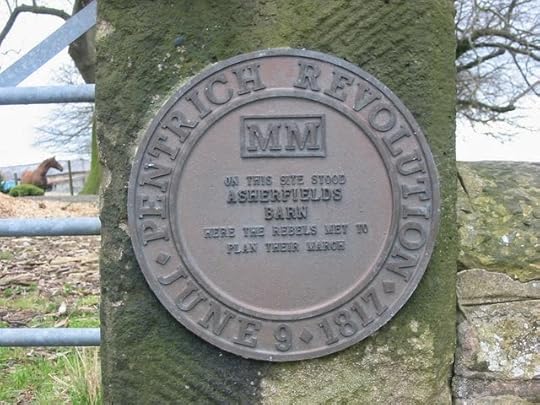
Concerned about the growing unrest, Lord Sidmouth, the Home Secretary sent spies throughout England, including the Midlands, to keep watch on the “centers of discontent.” Since these spies were informers paid by results, they quickly became agents provocateur, stirring rebellion where there was none so they would be paid. Among the spies was one William Richards, better known as William Oliver, or “Oliver the spy,” who incited open rebellion in the Midlands. He is one of the characters in my novel.Oliver traveled to Pentrich in Derbyshire, disguised as a depressed worker (he had previously been in Fleet Prison), encouraging the villagers to armed rebellion. He assured them there were thousands in London ready to join them in rising against the Crown. The villagers, in their ignorance, believed him. They were simple men who thought they were joining a great cause for democracy where every man would have a vote. They would soon learn they were wrong.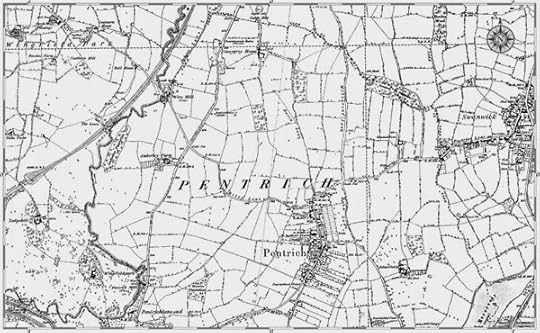
At the same time that Oliver was making arrangements with the villagers for an armed march to air their discontent, he informed the local militia of the planned uprising, even giving them the date. Due to Oliver’s lies, the hundreds who marched on that rainy night in June had no idea they stood not a chance of accomplishing their objective. When the dawn came, the men faced a regiment of the King’s Own Dragoons and were soon scattered or captured. Notwithstanding the circumstances of the uprising and the involvement of the English government, the powers in London decided to make an example of the rebels. Forty-five men were tried for high treason. Three were hanged, including Jeremiah Brandreth, Isaac Ludlam and William Turner, the “ringleaders”—all characters in my novel. Fourteen were sentenced to transportation to Australia, including one young man of whom my heroine was quite fond.
Years after the events, in a letter written in 1831, Lord Melbourne, a former Home Secretary, recalled that there was "much reason to suspect that the rising in Derbyshire...was stimulated, if not produced, by the artifices of Oliver, a spy employed by the Government of that day.”
My story begins in London where a young noblewoman flees a fate worse than death and runs unknowingly into the arms of a spy for the Crown.
* * *About the AuthorAs a child Regan Walker loved to write stories, particularly about adventure-loving girls, but by the time she got to college more serious pursuits took priority. One of her professors thought her suited to the profession of law, and Regan realized it would be better to be a hammer than a nail. Years of serving clients in private practice and several stints in high levels of government gave her a love of international travel and a feel for the demands of the “Crown” on its subjects. Hence her romance novels often involve a demanding Prince Regent who thinks of his subjects as his private talent pool.You can find Regan here:Author website: http://www.reganwalkerauthor.com/Regan’s Romance Reviews blog: http://reganromancereview.blogspot.com/Twitter: @RegansReview (https://twitter.com/RegansReview)Facebook: http://www.facebook.com/regan.walker.104Goodreads: http://www.goodreads.com/author/show/6450403.Regan_Walker
Excerpt:
Chapter 1London, April 1817She is dead. Katherine, Lady Egerton, stared at the still form lying on the bed. Beloved sister, friend of the heart…Anne was gone. One minute she was struggling for breath, the next she lay silent and still. The only person in the world Kit loved more than life had left her. They are all gone now. The sudden solitude tore at her heart. Kit smiled sadly, gazing through eyes filled with tears at the frail body lying before her. The brown mouse. Anne’s name for herself. Delicate even as a child, she had not long survived her marriage to the cruel Earl of Rutledge. Kit knelt at her sister’s bedside, assailed by grief and guilt, and reached for Anne’s hand. Could she have done more to save her sister from the dread disease? Could she have done more to protect Anne from the heartless man who was her husband? Pale in death, Anne was still beautiful. Kit had often sketched that heart-shaped face. Not a mouse, but a much-loved sister with a kind, unselfish heart. Kit had seen the end coming in the last few months, months through which she’d faithfully cared for Anne. The coughs that wracked her sister’s slight frame had grown worse as Anne seemed to fade before Kit’s eyes. Kit knew she was losing her even as she willed that weak body to heal. The physician said he could do nothing; each time he left shaking his head and telling Kit to make “the poor girl” comfortable as best she could. Kit had tried to save Anne, doing the only thing she knew by giving her syrup of horehound and honey. But such a small measure was not enough. Then, too, her sister had seemed to welcome death. Suddenly, the room grew cold. Kit felt his presence, a looming evil behind her. She took a deep breath and summoned her strength. “Leave her and come to me.” Rutledge’s tone was harsh and demanding. Kit had no need to see him to know his face would be twisted in an odious scowl, his lips drawn taut. “It is time.” “I must see to my sister.” “You need do nothing. I have arranged for the burial. Come away now.” Kit knew what he wanted, for she had seen the lust in his dark eyes. What at first had been sideways glances became leers and unwanted touches. Though she’d lived in his home since the death of her husband the baron, Kit had avoided the earl, rarely leaving her sister’s bedside. She had been thinking of a way to escape, but her exhaustion in caring for Anne these last days left those plans incomplete. With meager funds, her options were few. When she failed to rise at the earl’s direction, his hand roughly gripped her shoulder. She stiffened at the pain of his fingers digging into her skin. “I have waited long for you, Katherine, enduring that mockery of a marriage to your sister while all the while it was you I wanted, you I was promised. Now I shall have what is mine.” “No!” She rose swiftly, stepping back as she turned to face him. Revulsion rose in her throat. What did he mean by those words? She never had been promised to him! His smirk transfigured what many thought of as a handsome face. Hadn’t Anne at first been fooled by his aristocratic features and wavy brown hair? One had only to look closely to see his nature reflected in those thin lips and narrow eyes now focused on Kit. A deep furrow between his brows bore witness to his long having insisted upon having his way. When Kit sketched him, it had been as an attacking hawk. “What will you do?” he asked smugly. “Where will you go, m’dear? You are alone and without funds. I am the one who has provided food and shelter for both you and your weak sister, though I wanted only you. You are mine, Katherine, and I will have you.” Terror seized her. Cornered, her eyes darted about like an animal snared in a trap. His tall figure blocked the door to the corridor; the only way out led through his adjacent bedchamber. She fled toward it. She hastened into the room as he stalked after her, knowing she had but seconds, and her eyes searched for a weapon, something to hold him at bay. At the side of the fireplace were tools, short bars of iron that could fend off a man. But could she reach them in time? He lunged for her just as she ran toward the fireplace. His body collided with hers, and she fell upon the wooden floor with a thud. Pain shot through her hip. His body crashed down upon hers, forcing the air from her lungs. She gasped a breath just as his mouth crushed her lips, ruthlessly claiming dominance. Tearing away, she pushed against his shoulders with all her might, but his greater strength held her pinned to the floor. His hand gripped one breast and squeezed. She winced at the pain, but that was quickly forgotten the moment a greater terror seized her: His aroused flesh pressed into her belly. Violently she struggled, but to no avail. His wet lips slid down her throat to her heaving chest as his fingers gripped the top of her gown and yanked at the silk. Kit heard the fabric tear as he ripped her gown and the top of her chemise, and she felt the cool air on her naked breasts. Frantic, she mustered strength she did not know she had. Twisting in his grasp, she reached for the iron poker now a mere foot away. His mouth latched onto her breast where he voraciously sucked a nipple. Lost in his lust, he did not see her grasp the length of iron, raise it above him and bring it crashing down on his head. Stunned by the blow, he raised up, his eyes glazed. Kit let the bar fall again, this time with greater force. Blood spattered her chest and face as his body went limp. He slumped atop her. Kit’s heart pounded in her chest like a bird’s wing beating against a cage. Frantically she shoved his face from her breast and rolled his body to the floor. Unsteady at first, her breath coming in pants, Kit rose and looked down at the crumpled form lying before her, every nerve on edge as she gazed into that evil face, now deathly pale. Blood oozed from a gash in the earl’s left temple. There was no sign of life, no movement. I have killed him! Fear choked off her breath as she wiped blood from her face with a sleeve, and with one last look toward her sister’s bedchamber she raced from the room. Footsteps sounded down the hall. Alarmed at the prospect of encountering one of the earl’s servants who would summon a constable, Kit knew she must find a place to hide, and there was nowhere to hide in the house. Quietly stealing into her bedchamber, she grabbed her cloak and reticule, stuffing inside it the one piece of her jewelry that could be sold to sustain her, and fled the dwelling. Out on the street, she paused to draw her cloak tightly around her, desperate to cover her torn and bloody gown. Where could she go? Who would shelter her in the state she was in, given the deed she had done? Only one name came to her.
Willow House.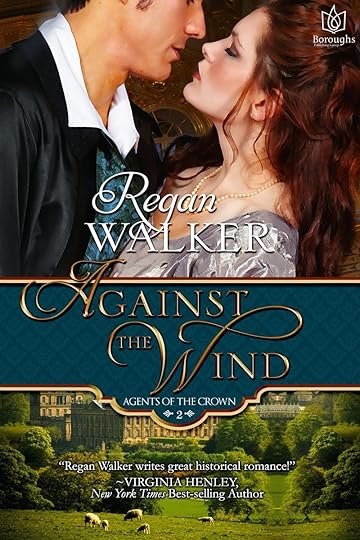
 A warm welcome to Regan WalkerEngland’s Last Revolution – When Mere Villagers Fought “Against the Wind”
A warm welcome to Regan WalkerEngland’s Last Revolution – When Mere Villagers Fought “Against the Wind”On June 9, 1817, a group of village men from Pentrich in Derbyshire, England rose in rebellion against the Crown. Dubbed “the Last Revolution in England,” it might have more accurately been called a government-inspired provocation to action, designed to justify repression. Why did the villages fight “against the wind” that was the power of England?
After the war with France ended in 1814, England suffered from great social, economic and political problems. Many of the major issues were the direct result of the war, but others were the necessary product of the changes occurring throughout society. The discontent and the distress in the lives of the common people culminated in the series of events between 1811-1819, including the Pentrich Rebellion of 1817, which is the backdrop for my historical romance novel, Against the Wind.
 Click for buy linkThe uprising in the Midlands in 1817 was just what the leaders of the British government needed to justify sending a strong signal to the masses that no rebellion, such as occurred in the French Revolution, would be tolerated in England. The hundreds of villagers who rose up with the pikes and crude weapons on that day in June two hundred years ago were ignorant of the true fact—that the government itself was behind their actions.
Click for buy linkThe uprising in the Midlands in 1817 was just what the leaders of the British government needed to justify sending a strong signal to the masses that no rebellion, such as occurred in the French Revolution, would be tolerated in England. The hundreds of villagers who rose up with the pikes and crude weapons on that day in June two hundred years ago were ignorant of the true fact—that the government itself was behind their actions. The year 1817 began with a rally held in London in January, perhaps inspired by the political clubs that advocated the vote for all men. The mood of the masses was rebellious and ended with stones being thrown at the Prince Regent’s carriage as he left Parliament. While the Prince wasn’t harmed, with memories of the French Revolution still vivid in their minds, and the political clubs becoming more and more popular, especially in the Midlands and the North, the House of Lords adopted a spate of laws designed to control the stirrings of rebellion, including the suspension of Habeas Corpus, and the infamous Gagging Acts. All public meetings were forbidden, except under license from local magistrates. Pubs and coffee houses, as especially notorious places for radical gatherings, were covered by the Acts. Sedition, that is to say opposition to the government, whether by speech or written word, was to be severely punished.
In March, there was a protest by thousands of depressed Manchester workers. With a view to descending on London to petition the Prince Regent to do something to relieve their economic depression, they marched peacefully carrying blankets to sleep in. Thus, it became known as the March of the Blanketeers. It rained violently on the day the march began. As five hundred of the men marched towards Derby, they encountered masses of troops at the Hanging Bridge over the River Dove at Ashbourne. Most of the Blanketeers were turned away, but twenty-five were arrested. Only a few got to Derby and only one marcher reached London to present his petition. However, the Manchester expression of discontent served to keep alive the government’s fear of revolution.

Concerned about the growing unrest, Lord Sidmouth, the Home Secretary sent spies throughout England, including the Midlands, to keep watch on the “centers of discontent.” Since these spies were informers paid by results, they quickly became agents provocateur, stirring rebellion where there was none so they would be paid. Among the spies was one William Richards, better known as William Oliver, or “Oliver the spy,” who incited open rebellion in the Midlands. He is one of the characters in my novel.Oliver traveled to Pentrich in Derbyshire, disguised as a depressed worker (he had previously been in Fleet Prison), encouraging the villagers to armed rebellion. He assured them there were thousands in London ready to join them in rising against the Crown. The villagers, in their ignorance, believed him. They were simple men who thought they were joining a great cause for democracy where every man would have a vote. They would soon learn they were wrong.

At the same time that Oliver was making arrangements with the villagers for an armed march to air their discontent, he informed the local militia of the planned uprising, even giving them the date. Due to Oliver’s lies, the hundreds who marched on that rainy night in June had no idea they stood not a chance of accomplishing their objective. When the dawn came, the men faced a regiment of the King’s Own Dragoons and were soon scattered or captured. Notwithstanding the circumstances of the uprising and the involvement of the English government, the powers in London decided to make an example of the rebels. Forty-five men were tried for high treason. Three were hanged, including Jeremiah Brandreth, Isaac Ludlam and William Turner, the “ringleaders”—all characters in my novel. Fourteen were sentenced to transportation to Australia, including one young man of whom my heroine was quite fond.
Years after the events, in a letter written in 1831, Lord Melbourne, a former Home Secretary, recalled that there was "much reason to suspect that the rising in Derbyshire...was stimulated, if not produced, by the artifices of Oliver, a spy employed by the Government of that day.”
My story begins in London where a young noblewoman flees a fate worse than death and runs unknowingly into the arms of a spy for the Crown.
* * *About the AuthorAs a child Regan Walker loved to write stories, particularly about adventure-loving girls, but by the time she got to college more serious pursuits took priority. One of her professors thought her suited to the profession of law, and Regan realized it would be better to be a hammer than a nail. Years of serving clients in private practice and several stints in high levels of government gave her a love of international travel and a feel for the demands of the “Crown” on its subjects. Hence her romance novels often involve a demanding Prince Regent who thinks of his subjects as his private talent pool.You can find Regan here:Author website: http://www.reganwalkerauthor.com/Regan’s Romance Reviews blog: http://reganromancereview.blogspot.com/Twitter: @RegansReview (https://twitter.com/RegansReview)Facebook: http://www.facebook.com/regan.walker.104Goodreads: http://www.goodreads.com/author/show/6450403.Regan_Walker
Excerpt:
Chapter 1London, April 1817She is dead. Katherine, Lady Egerton, stared at the still form lying on the bed. Beloved sister, friend of the heart…Anne was gone. One minute she was struggling for breath, the next she lay silent and still. The only person in the world Kit loved more than life had left her. They are all gone now. The sudden solitude tore at her heart. Kit smiled sadly, gazing through eyes filled with tears at the frail body lying before her. The brown mouse. Anne’s name for herself. Delicate even as a child, she had not long survived her marriage to the cruel Earl of Rutledge. Kit knelt at her sister’s bedside, assailed by grief and guilt, and reached for Anne’s hand. Could she have done more to save her sister from the dread disease? Could she have done more to protect Anne from the heartless man who was her husband? Pale in death, Anne was still beautiful. Kit had often sketched that heart-shaped face. Not a mouse, but a much-loved sister with a kind, unselfish heart. Kit had seen the end coming in the last few months, months through which she’d faithfully cared for Anne. The coughs that wracked her sister’s slight frame had grown worse as Anne seemed to fade before Kit’s eyes. Kit knew she was losing her even as she willed that weak body to heal. The physician said he could do nothing; each time he left shaking his head and telling Kit to make “the poor girl” comfortable as best she could. Kit had tried to save Anne, doing the only thing she knew by giving her syrup of horehound and honey. But such a small measure was not enough. Then, too, her sister had seemed to welcome death. Suddenly, the room grew cold. Kit felt his presence, a looming evil behind her. She took a deep breath and summoned her strength. “Leave her and come to me.” Rutledge’s tone was harsh and demanding. Kit had no need to see him to know his face would be twisted in an odious scowl, his lips drawn taut. “It is time.” “I must see to my sister.” “You need do nothing. I have arranged for the burial. Come away now.” Kit knew what he wanted, for she had seen the lust in his dark eyes. What at first had been sideways glances became leers and unwanted touches. Though she’d lived in his home since the death of her husband the baron, Kit had avoided the earl, rarely leaving her sister’s bedside. She had been thinking of a way to escape, but her exhaustion in caring for Anne these last days left those plans incomplete. With meager funds, her options were few. When she failed to rise at the earl’s direction, his hand roughly gripped her shoulder. She stiffened at the pain of his fingers digging into her skin. “I have waited long for you, Katherine, enduring that mockery of a marriage to your sister while all the while it was you I wanted, you I was promised. Now I shall have what is mine.” “No!” She rose swiftly, stepping back as she turned to face him. Revulsion rose in her throat. What did he mean by those words? She never had been promised to him! His smirk transfigured what many thought of as a handsome face. Hadn’t Anne at first been fooled by his aristocratic features and wavy brown hair? One had only to look closely to see his nature reflected in those thin lips and narrow eyes now focused on Kit. A deep furrow between his brows bore witness to his long having insisted upon having his way. When Kit sketched him, it had been as an attacking hawk. “What will you do?” he asked smugly. “Where will you go, m’dear? You are alone and without funds. I am the one who has provided food and shelter for both you and your weak sister, though I wanted only you. You are mine, Katherine, and I will have you.” Terror seized her. Cornered, her eyes darted about like an animal snared in a trap. His tall figure blocked the door to the corridor; the only way out led through his adjacent bedchamber. She fled toward it. She hastened into the room as he stalked after her, knowing she had but seconds, and her eyes searched for a weapon, something to hold him at bay. At the side of the fireplace were tools, short bars of iron that could fend off a man. But could she reach them in time? He lunged for her just as she ran toward the fireplace. His body collided with hers, and she fell upon the wooden floor with a thud. Pain shot through her hip. His body crashed down upon hers, forcing the air from her lungs. She gasped a breath just as his mouth crushed her lips, ruthlessly claiming dominance. Tearing away, she pushed against his shoulders with all her might, but his greater strength held her pinned to the floor. His hand gripped one breast and squeezed. She winced at the pain, but that was quickly forgotten the moment a greater terror seized her: His aroused flesh pressed into her belly. Violently she struggled, but to no avail. His wet lips slid down her throat to her heaving chest as his fingers gripped the top of her gown and yanked at the silk. Kit heard the fabric tear as he ripped her gown and the top of her chemise, and she felt the cool air on her naked breasts. Frantic, she mustered strength she did not know she had. Twisting in his grasp, she reached for the iron poker now a mere foot away. His mouth latched onto her breast where he voraciously sucked a nipple. Lost in his lust, he did not see her grasp the length of iron, raise it above him and bring it crashing down on his head. Stunned by the blow, he raised up, his eyes glazed. Kit let the bar fall again, this time with greater force. Blood spattered her chest and face as his body went limp. He slumped atop her. Kit’s heart pounded in her chest like a bird’s wing beating against a cage. Frantically she shoved his face from her breast and rolled his body to the floor. Unsteady at first, her breath coming in pants, Kit rose and looked down at the crumpled form lying before her, every nerve on edge as she gazed into that evil face, now deathly pale. Blood oozed from a gash in the earl’s left temple. There was no sign of life, no movement. I have killed him! Fear choked off her breath as she wiped blood from her face with a sleeve, and with one last look toward her sister’s bedchamber she raced from the room. Footsteps sounded down the hall. Alarmed at the prospect of encountering one of the earl’s servants who would summon a constable, Kit knew she must find a place to hide, and there was nowhere to hide in the house. Quietly stealing into her bedchamber, she grabbed her cloak and reticule, stuffing inside it the one piece of her jewelry that could be sold to sustain her, and fled the dwelling. Out on the street, she paused to draw her cloak tightly around her, desperate to cover her torn and bloody gown. Where could she go? Who would shelter her in the state she was in, given the deed she had done? Only one name came to her.
Willow House.

Published on April 03, 2014 00:15
April 2, 2014
Florence Nightingale and a Dog Called Cap
How did a sheepdog influence Florence Nightingale’s career?
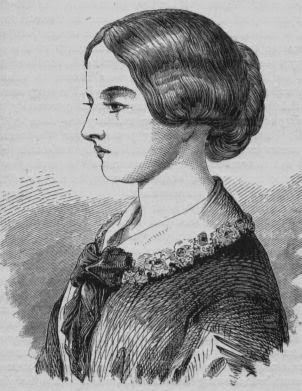 Florence Nightingale as a young womanBorn in 1820, Florence Nightingale was an extraordinary woman who defied her parents’ wishes and became a nurse. Her work overseeing disease control and hygiene in hospitals was ground-breaking and laid the foundations of modern nursing. Amongst the soldiers she cared for during the Crimean War she became affectionately known as ‘the Lady of the Lamp.’ After the war, Florence returned to England and established a school of nursing at St. Thomas’ Hospital, London. Such were her contributions to medicine that in 1907 she was awarded the British Order of Merit – the first woman to be so honoured. Yet all this may not have happened had it not been for a chance meeting with a sheepdog.
Florence Nightingale as a young womanBorn in 1820, Florence Nightingale was an extraordinary woman who defied her parents’ wishes and became a nurse. Her work overseeing disease control and hygiene in hospitals was ground-breaking and laid the foundations of modern nursing. Amongst the soldiers she cared for during the Crimean War she became affectionately known as ‘the Lady of the Lamp.’ After the war, Florence returned to England and established a school of nursing at St. Thomas’ Hospital, London. Such were her contributions to medicine that in 1907 she was awarded the British Order of Merit – the first woman to be so honoured. Yet all this may not have happened had it not been for a chance meeting with a sheepdog.
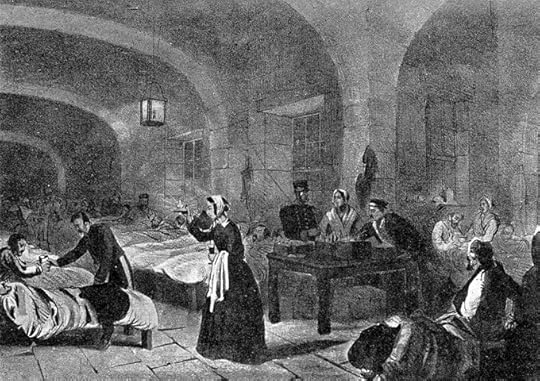 Florence doing ward rounds at night.
Florence doing ward rounds at night.
The Lady of the LampFlorence came from a well to do family with homes in both Derbyshire and London. She lived at a time when women from wealthy families were expected marry and have children, and most certainly not work for a living. However, an encounter with a sheepdog called Cap, triggered a series of events that led to Florence defying convention.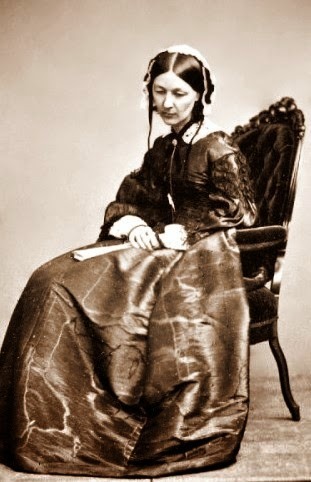 Portrait of Florence Nightingale - approx 1854When Florence was 17 she went for an afternoon ride with a clergyman companion, in the countryside near Matlock, Derbyshire. Florence liked dogs and often stopped at the cottage of a local farmer to fuss his sheepdog, Cap. However, on this occasion Florence discovered all was not well.
Portrait of Florence Nightingale - approx 1854When Florence was 17 she went for an afternoon ride with a clergyman companion, in the countryside near Matlock, Derbyshire. Florence liked dogs and often stopped at the cottage of a local farmer to fuss his sheepdog, Cap. However, on this occasion Florence discovered all was not well.
Earlier in the day Cap had been asleep on the cottage doorstep when some young lads happened past. For whatever reason, heaven only knows why, they threw stones at the dog. One rock hit his front leg and hurt the dog such that he couldn’t walk on the leg. The farmer, Roger, was a poor man and whilst he needed a working dog he could not afford to feed a pet. Florence was horrified to learn that Roger assumed the leg was broken and intended, later in the day, to put Cap out of his pain and hang him.
Florence’s companion convinced the farmer to let him examine the dog’s leg. He realized that instead of the bone being broken it was severely bruised. The clergyman instructed Florence on how to apply a poultice and bandage the limb, and she convinced Roger to let her return the next to change the dressing.Happily, just two days later Florence encountered Roger and his flock on a hill, with an excited and only slightly lame Cap at his side. This was the first patient Florence nursed back to health. The following night she had a dream in which she believed God was calling her to devote her life to healing the sick. This became her life’s mission – even if it was nearly a decade before she realized that dream and trained as a nurse.
 Florence Nightingale as a young womanBorn in 1820, Florence Nightingale was an extraordinary woman who defied her parents’ wishes and became a nurse. Her work overseeing disease control and hygiene in hospitals was ground-breaking and laid the foundations of modern nursing. Amongst the soldiers she cared for during the Crimean War she became affectionately known as ‘the Lady of the Lamp.’ After the war, Florence returned to England and established a school of nursing at St. Thomas’ Hospital, London. Such were her contributions to medicine that in 1907 she was awarded the British Order of Merit – the first woman to be so honoured. Yet all this may not have happened had it not been for a chance meeting with a sheepdog.
Florence Nightingale as a young womanBorn in 1820, Florence Nightingale was an extraordinary woman who defied her parents’ wishes and became a nurse. Her work overseeing disease control and hygiene in hospitals was ground-breaking and laid the foundations of modern nursing. Amongst the soldiers she cared for during the Crimean War she became affectionately known as ‘the Lady of the Lamp.’ After the war, Florence returned to England and established a school of nursing at St. Thomas’ Hospital, London. Such were her contributions to medicine that in 1907 she was awarded the British Order of Merit – the first woman to be so honoured. Yet all this may not have happened had it not been for a chance meeting with a sheepdog.
 Florence doing ward rounds at night.
Florence doing ward rounds at night.The Lady of the LampFlorence came from a well to do family with homes in both Derbyshire and London. She lived at a time when women from wealthy families were expected marry and have children, and most certainly not work for a living. However, an encounter with a sheepdog called Cap, triggered a series of events that led to Florence defying convention.
 Portrait of Florence Nightingale - approx 1854When Florence was 17 she went for an afternoon ride with a clergyman companion, in the countryside near Matlock, Derbyshire. Florence liked dogs and often stopped at the cottage of a local farmer to fuss his sheepdog, Cap. However, on this occasion Florence discovered all was not well.
Portrait of Florence Nightingale - approx 1854When Florence was 17 she went for an afternoon ride with a clergyman companion, in the countryside near Matlock, Derbyshire. Florence liked dogs and often stopped at the cottage of a local farmer to fuss his sheepdog, Cap. However, on this occasion Florence discovered all was not well.Earlier in the day Cap had been asleep on the cottage doorstep when some young lads happened past. For whatever reason, heaven only knows why, they threw stones at the dog. One rock hit his front leg and hurt the dog such that he couldn’t walk on the leg. The farmer, Roger, was a poor man and whilst he needed a working dog he could not afford to feed a pet. Florence was horrified to learn that Roger assumed the leg was broken and intended, later in the day, to put Cap out of his pain and hang him.

Florence’s companion convinced the farmer to let him examine the dog’s leg. He realized that instead of the bone being broken it was severely bruised. The clergyman instructed Florence on how to apply a poultice and bandage the limb, and she convinced Roger to let her return the next to change the dressing.Happily, just two days later Florence encountered Roger and his flock on a hill, with an excited and only slightly lame Cap at his side. This was the first patient Florence nursed back to health. The following night she had a dream in which she believed God was calling her to devote her life to healing the sick. This became her life’s mission – even if it was nearly a decade before she realized that dream and trained as a nurse.

Published on April 02, 2014 03:23
'Familiar Felines.'
Following on from last weeks Halloween posting, today's blog post looks at the unwanted image of cats as the witches familiar - from the Norse Goddess Freya to lonely women in the middle ages.
The full Following on from last weeks Halloween posting, today's blog post looks at the unwanted image of cats as the witches familiar - from the Norse Goddess Freya to lonely women in the middle ages.
The full post can found at:
http://graceelliot-author.blogspot.com
...more
The full Following on from last weeks Halloween posting, today's blog post looks at the unwanted image of cats as the witches familiar - from the Norse Goddess Freya to lonely women in the middle ages.
The full post can found at:
http://graceelliot-author.blogspot.com
...more
- Grace Elliot's profile
- 156 followers



